Effects of Recreational Football on Body Composition and Cardiometabolic Health in Overweight or Obese Individuals: A Systematic Review and Meta-Analysis
Abstract
1. Introduction
2. Methods
2.1. Information Sources and Search Strategy
2.2. Selection Process
2.3. Eligibility Criteria
2.4. Data Extraction
2.5. Risk of Bias and Quality of Methods Assessment
2.6. Statistical Analysis
2.7. Certainty of the Evidence
3. Results
3.1. Studies Retrieved
3.2. Characteristics of the Included Studies
3.3. Effects of Recreational Football on Body Composition
3.3.1. Body Weight and Body Mass Index
3.3.2. Body Fat, Fat Mass, and Lean Body Mass
3.3.3. Waist Circumference
3.4. Effects of Recreational Football on Cardiometabolic Health
3.4.1. Resting Blood Pressure and Heart Rate
3.4.2. Peak/Maximal Oxygen Uptake
3.4.3. Lipid Metabolism
3.4.4. Glucose Metabolism
3.5. Sensitivity Analysis
3.6. Risk of Bias and Methodological Quality
3.7. Results of the Certainty of the Evidence
4. Discussion
4.1. Body Composition
4.2. Cardiovascular Health
4.3. Lipid and Glucose Metabolism
4.4. Limitations and Future Directions
4.5. Practical Implications
5. Conclusions
Author Contributions
Funding
Institutional Review Board Statement
Informed Consent Statement
Data Availability Statement
Conflicts of Interest
Appendix A. PRISMA
| Section/Topic | # | Checklist Item | Reported on Page # |
| Effects of Recreational Football on Body Composition and Cardiometabolic Health in Overweight or Obese Individuals: A Systematic Review and Meta-Analysis | |||
| Title | 1 | Identify the report as a systematic review, meta-analysis, or both. | 1 |
| Structured summary | 2 | Provide a structured summary including as applicable: background; objectives; data sources; study eligibility criteria, participants, and interventions; study appraisal and synthesis methods; results; limitations; conclusions and implications of key findings; systematic review registration number. | 1 |
| INTRODUCTION | |||
| Rationale | 3 | Describe the rationale for the review in the context of what is already known. | 2 |
| Objectives | 4 | Provide an explicit statement of questions being addressed with reference to participants, interventions, comparisons, outcomes, and study design (PICOS). | 2 |
| METHODS | |||
| Protocol and registration | 5 | Indicate if a review protocol exists, if and where it can be accessed (e.g., Web address), and, if available, provide registration information, including registration number. | 3 |
| Eligibility criteria | 6 | Specify study characteristics (e.g., PICOS, length of follow-up) and report characteristics (e.g., years considered, language, publication status) used as criteria for eligibility, giving rationale. | 4 |
| Information sources | 7 | Describe all information sources (e.g., databases with dates of coverage, contact with study authors to identify additional studies) in the search and date last searched. | 4 |
| Search | 8 | Present full electronic search strategy for at least one database, including any limits used, such that it could be repeated. | 4 |
| Study selection | 9 | State the process for selecting studies (i.e., screening, eligibility, included in systematic review, and, if applicable, included in the meta-analysis). | 5 |
| Data collection process | 10 | Describe method of data extraction from reports (e.g., piloted forms, independently, in duplicate) and any processes for obtaining and confirming data from investigators. | 5 |
| Data items | 11 | List and define all variables for which data were sought (e.g., PICOS, funding sources) and any assumptions and simplifications made. | 6 |
| Risk of bias in individual studies | 12 | Describe methods used for assessing risk of bias in individual studies (including specification of whether this was conducted at the study or outcome level), and how this information is to be used in any data synthesis. | 5 |
| Summary measures | 13 | State the principal summary measures (e.g., risk ratio, difference in means). | 5 |
| Synthesis of results | 14 | Describe the methods of handling data and combining results of studies, if conducted, including measures of consistency (e.g., I2), for each meta-analysis. | 6 |
| Section/Topic | # | Checklist Item | Reported on Page # |
| Risk of bias across studies | 15 | Specify any assessment of the risk of bias that may affect the cumulative evidence (e.g., publication bias, selective reporting within studies). | 5 |
| Additional analyses | 16 | Describe methods of additional analyses (e.g., sensitivity or subgroup analyses, meta-regression), if conducted, indicating which were prespecified. | 6 |
| RESULTS | |||
| Study selection | 17 | Provide numbers of studies screened, assessed for eligibility, and included in the review, with reasons for exclusions at each stage, ideally using a flow diagram. | 7 |
| Study characteristics | 18 | For each study, present characteristics for which data were extracted (e.g., study size, PICOS, follow-up period) and provide the citations. | 7 |
| Risk of bias within studies | 19 | Present data on the risk of bias in each study and, if available, any outcome level assessment (see item 12). | 13 |
| Results of individual studies | 20 | For all outcomes considered (benefits or harms), present, for each study: (a) simple summary data for each intervention group, (b) effect estimates and confidence intervals, ideally using a forest plot. | 6–13 |
| Synthesis of results | 21 | Present results of each meta-analysis conducted, including confidence intervals and measures of consistency. | 6–13 |
| Risk of bias across studies | 22 | Present results of any assessment of risk of bias across studies (see Item 15). | 13 |
| Additional analysis | 23 | Provide results of additional analyses, if conducted (e.g., sensitivity or subgroup analyses, meta-regression [see Item 16]). | 6–13 |
| DISCUSSION | |||
| Summary of evidence | 24 | Summarize the main findings including the strength of evidence for each main outcome; consider their relevance to key groups (e.g., healthcare providers, users, and policy makers). | 16 |
| Limitations | 25 | Discuss limitations at study and outcome level (e.g., risk of bias), and at review level (e.g., incomplete retrieval of identified research, reporting bias). | 23,24 |
| Conclusions | 26 | Provide a general interpretation of the results in the context of other evidence, and implications for future research. | 24 |
| FUNDING | |||
| Funding | 27 | Describe sources of funding for the systematic review and other support (e.g., supply of data); role of funders for the systematic review. | n/a |
Appendix B. Forest Plot of Body Composition
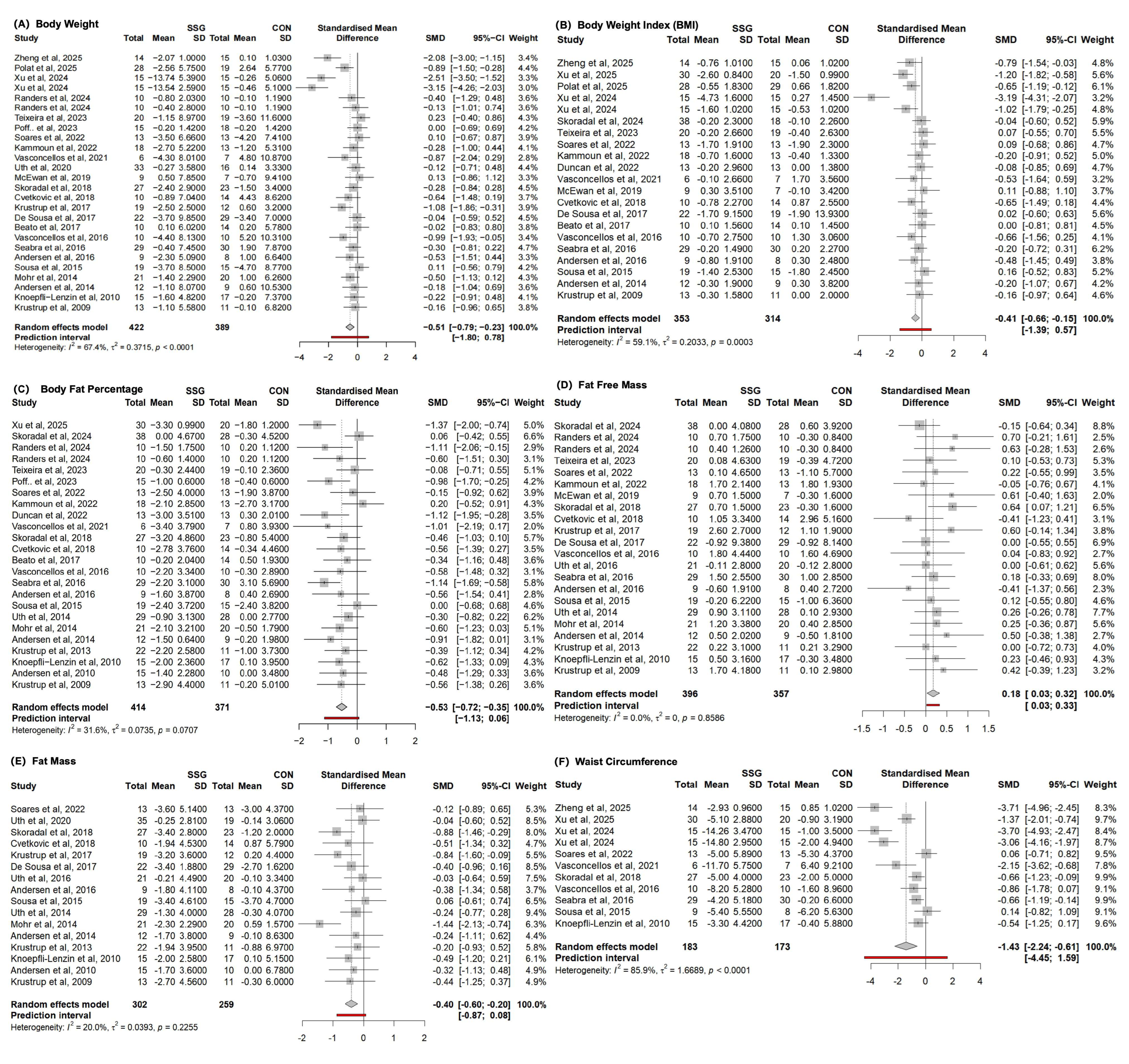
Appendix C. Forest Plot of Cardiovascular Health
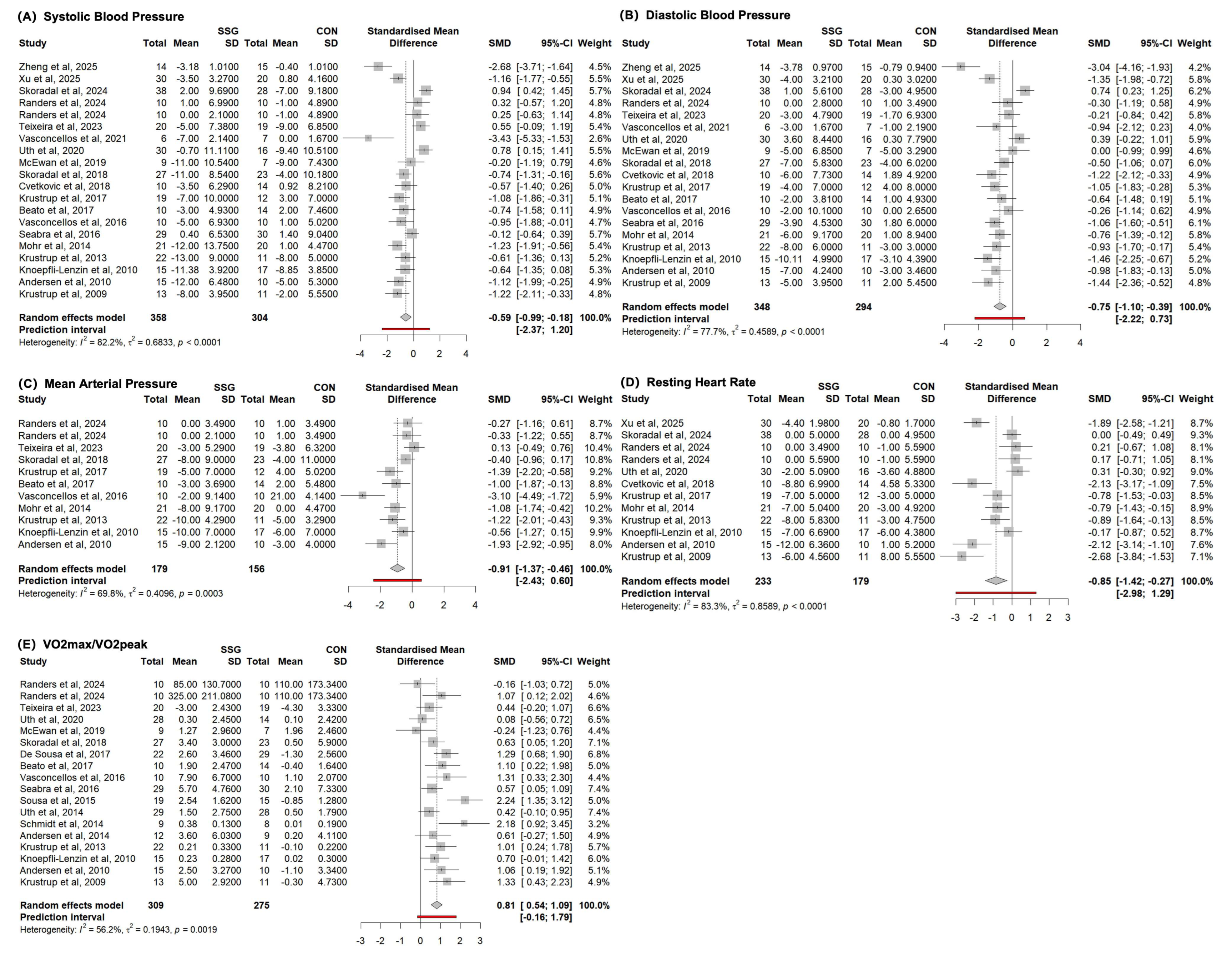
Appendix D. Forest Plot of Glucose and Lipid Metabolism
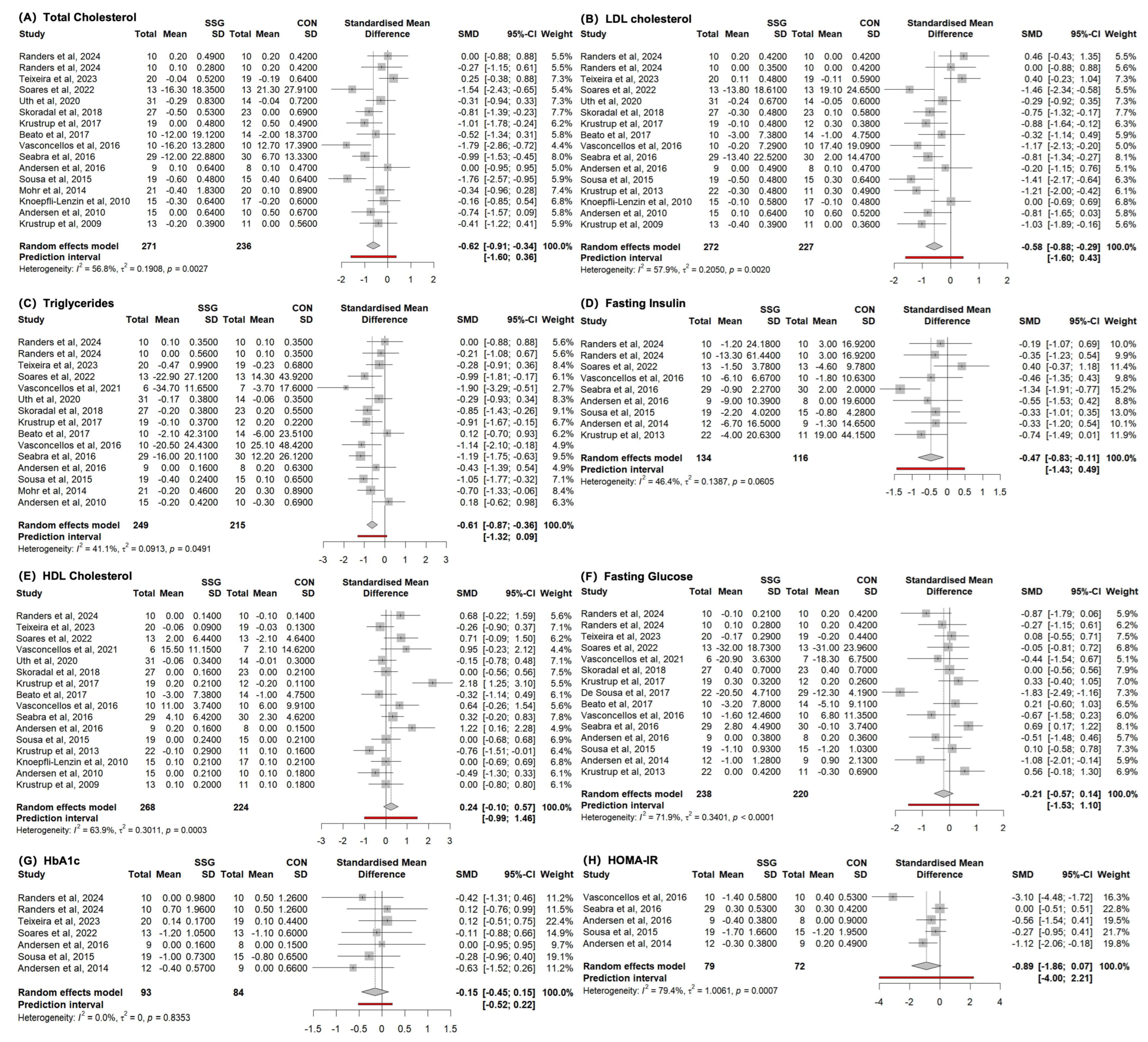
Appendix E. Sensitivity Analysis Plot of Body Composition
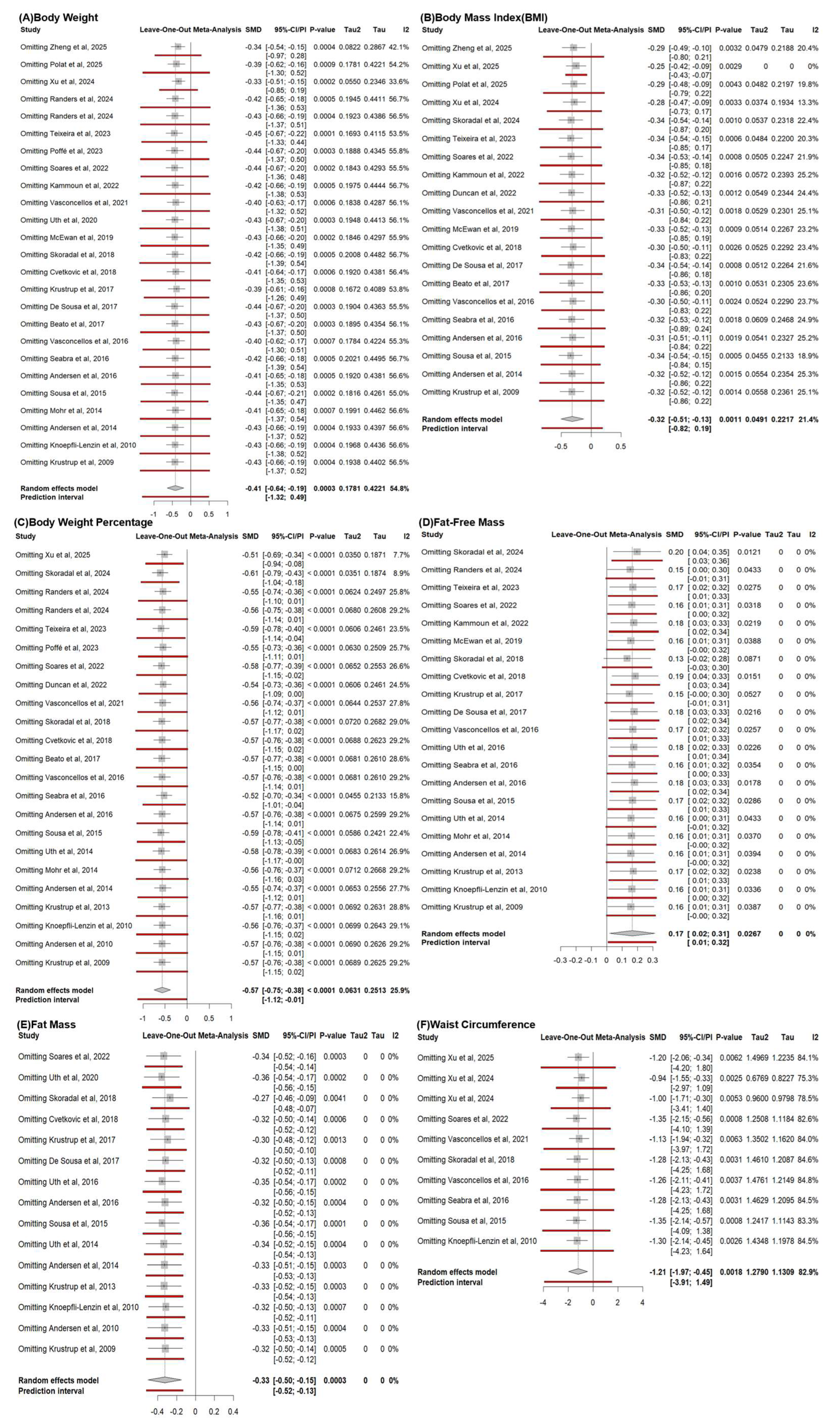
Appendix F. Sensitivity Analysis Plot of Cardiovascular Health
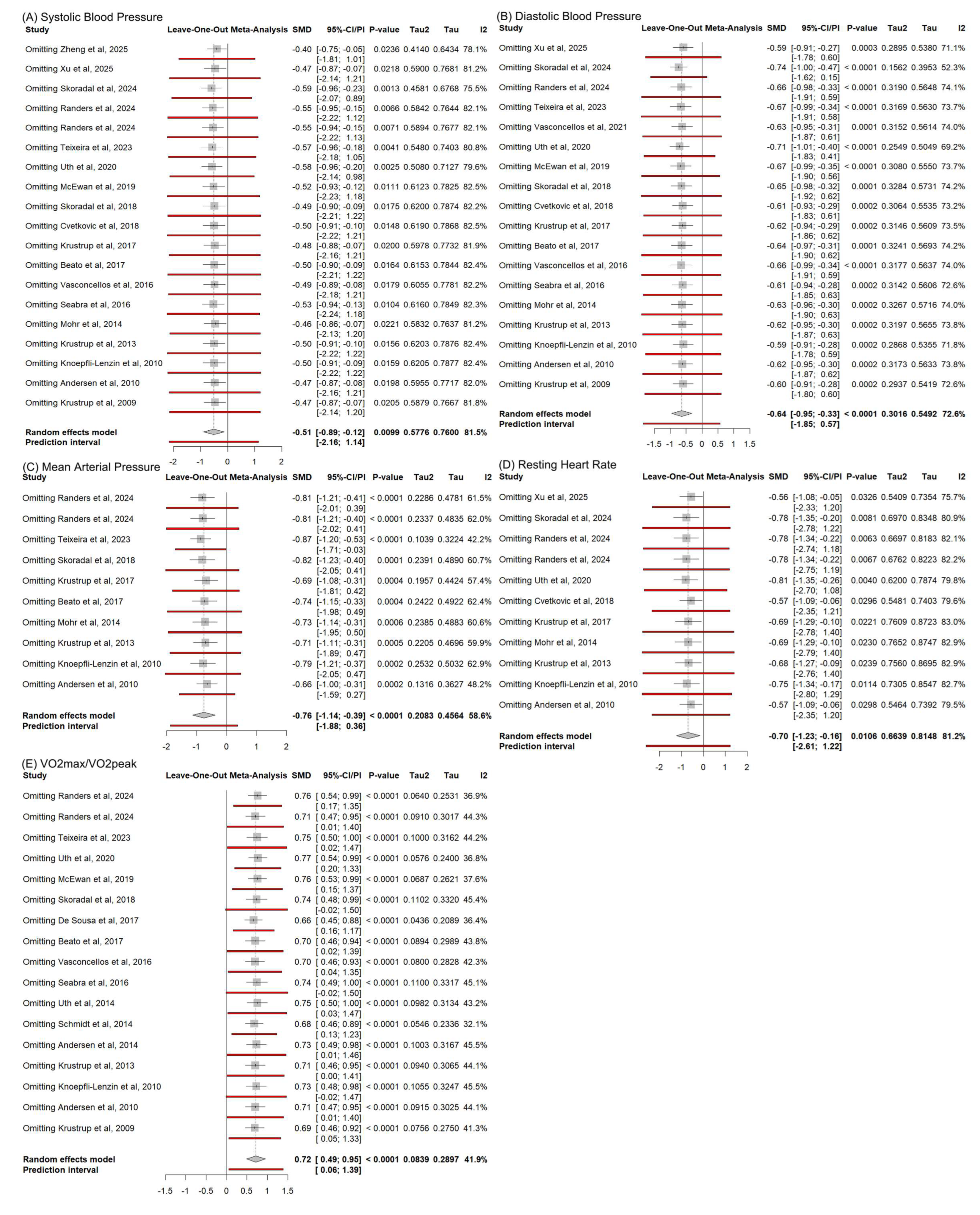
Appendix G. Sensitivity Analysis Plot of Glucose and Lipid Metabolism
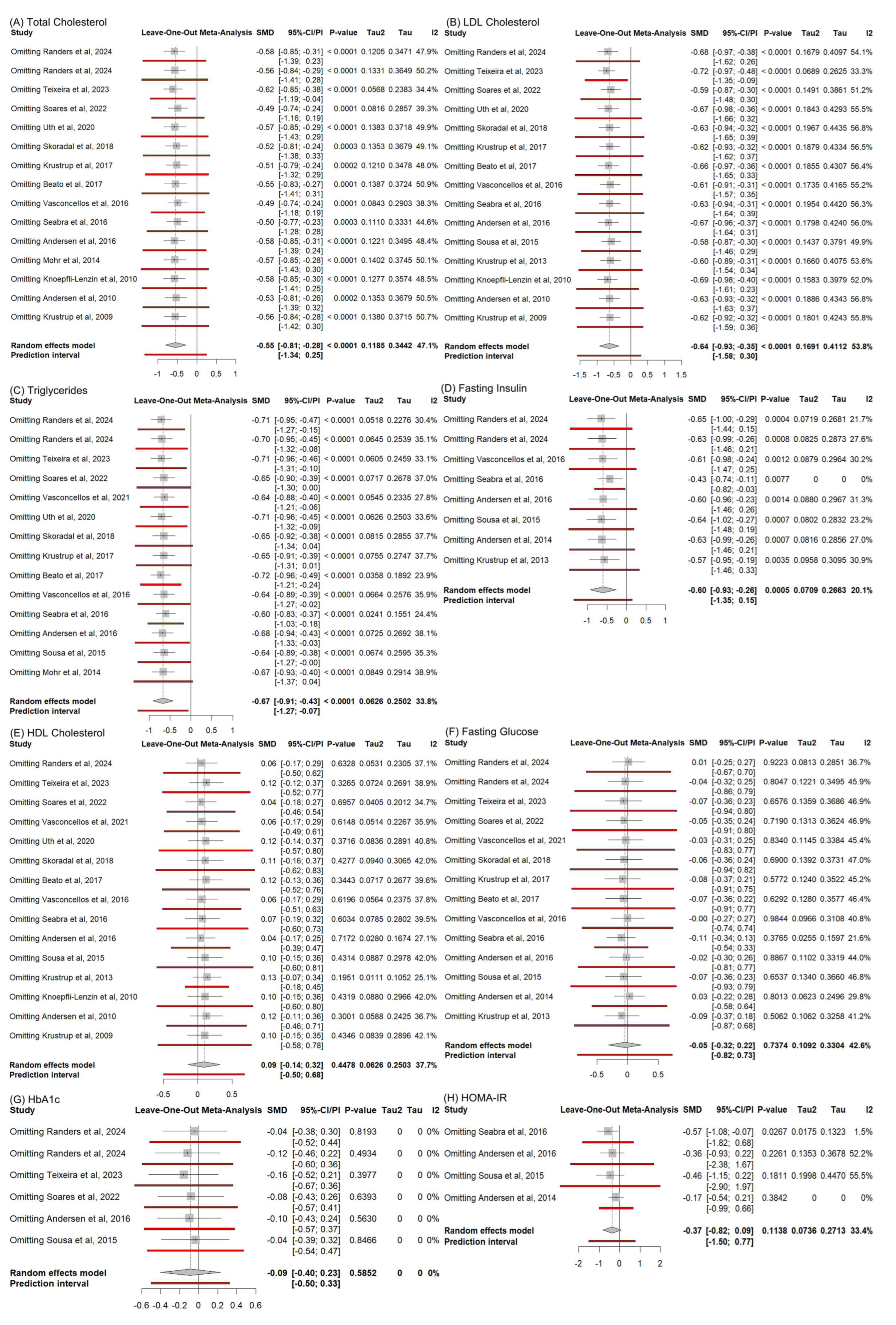
References
- Ng, M.; Fleming, T.; Robinson, M.; Thomson, B.; Graetz, N.; Margono, C.; Mullany, E.C.; Biryukov, S.; Abbafati, C.; Abera, S.F.; et al. Global, regional, and national prevalence of overweight and obesity in children and adults during 1980–2013: A systematic analysis for the Global Burden of Disease Study 2013. Lancet 2014, 384, 766–781. [Google Scholar] [CrossRef]
- Bray, G.A.; Frühbeck, G.; Ryan, D.H.; Wilding, J.P.H. Management of obesity. Lancet 2016, 387, 1947–1956. [Google Scholar] [CrossRef]
- Anderson, L.N.; Yoshida-Montezuma, Y.; Dewart, N.; Jalil, E.; Khattar, J.; Rubeis, V.D.; Carsley, S.; Griffith, L.E.; Mbuagbaw, L. Obesity and weight change during the COVID-19 pandemic in children and adults: A systematic review and meta-analysis. Obes. Rev. Off. J. Int. Assoc. Study Obes. 2023, 24, e13550. [Google Scholar] [CrossRef] [PubMed]
- Savage, D.B.; Petersen, K.F.; Shulman, G.I. Disordered lipid metabolism and the pathogenesis of insulin resistance. Physiol. Rev. 2007, 87, 507–520. [Google Scholar] [CrossRef]
- Wolfe, R.R. The underappreciated role of muscle in health and disease. Am. J. Clin. Nutr. 2006, 84, 475–482. [Google Scholar] [CrossRef]
- Brun, J.-F.; Myzia, J.; Varlet-Marie, E.; de Mauverger, E.R.; Mercier, J. Beyond the Calorie Paradigm: Taking into Account in Practice the Balance of Fat and Carbohydrate Oxidation during Exercise? Nutrients 2022, 14, 1605. [Google Scholar] [CrossRef] [PubMed]
- Galgani, J.; Ravussin, E. Energy metabolism, fuel selection and body weight regulation. Int. J. Obes. 2008, 32 (Suppl. S7), S109–S119. [Google Scholar] [CrossRef]
- Swift, D.L.; Johannsen, N.M.; Lavie, C.J.; Earnest, C.P.; Church, T.S. The Role of Exercise and Physical Activity in Weight Loss and Maintenance. Prog. Cardiovasc. Dis. 2014, 56, 441–447. [Google Scholar] [CrossRef] [PubMed]
- Krustrup, P.; Williams, C.A.; Mohr, M.; Hansen, P.R.; Helge, E.W.; Elbe, A.-M.; de Sousa, M.; Dvorak, J.; Junge, A.; Hammami, A.; et al. The “Football is Medicine” platform-scientific evidence, large-scale implementation of evidence-based concepts and future perspectives. Scand. J. Med. Sci. Sports 2018, 28 (Suppl. S1), 3–7. [Google Scholar] [CrossRef]
- Milanović, Z.; Čović, N.; Helge, E.W.; Krustrup, P.; Mohr, M. Recreational Football and Bone Health: A Systematic Review and Meta-analysis. Sports Med. 2022, 52, 3021–3037. [Google Scholar] [CrossRef]
- Milanović, Z.; Pantelić, S.; Čović, N.; Sporiš, G.; Mohr, M.; Krustrup, P. Broad-spectrum physical fitness benefits of recreational football: A systematic review and meta-analysis. Br. J. Sports Med. 2019, 53, 926–939. [Google Scholar] [CrossRef]
- Milanović, Z.; Pantelić, S.; Čović, N.; Sporiš, G.; Krustrup, P. Is Recreational Soccer Effective for Improving VO2max A Systematic Review and Meta-Analysis. Sports Med. 2015, 45, 1339–1353. [Google Scholar] [CrossRef]
- Page, M.J.; McKenzie, J.E.; Bossuyt, P.M.; Boutron, I.; Hoffmann, T.C.; Mulrow, C.D.; Shamseer, L.; Tetzlaff, J.M.; Akl, E.A.; Brennan, S.E.; et al. The PRISMA 2020 statement: An updated guideline for reporting systematic reviews. BMJ 2021, 372, n71. [Google Scholar] [CrossRef]
- Schwarzer, G. meta: An R Package for Meta-Analysis. R News 2007, 7, 40–45. [Google Scholar]
- Viechtbauer, W. Conducting Meta-Analyses in R with the metafor Package. J. Stat. Softw. 2010, 36, 1–48. [Google Scholar] [CrossRef]
- DerSimonian, R.; Laird, N. Meta-analysis in clinical trials revisited. Contemp. Clin. Trials 2015, 45 Pt A, 139–145. [Google Scholar] [CrossRef] [PubMed]
- Nagashima, K.; Noma, H.; Furukawa, T.A. Prediction intervals for random-effects meta-analysis: A confidence distribution approach. Stat. Methods Med. Res. 2019, 28, 1689–1702. [Google Scholar] [CrossRef] [PubMed]
- Nakagawa, S.; Lagisz, M.; O’Dea, R.E.; Rutkowska, J.; Yang, Y.; Noble, D.W.A.; Senior, A.M. The orchard plot: Cultivating a forest plot for use in ecology, evolution, and beyond. Res. Synth. Methods 2021, 12, 4–12. [Google Scholar] [CrossRef] [PubMed]
- Nakagawa, S.; Noble, D.W.A.; Senior, A.M.; Lagisz, M. Meta-evaluation of meta-analysis: Ten appraisal questions for biologists. BMC Biol. 2017, 15, 18. [Google Scholar] [CrossRef]
- Cumpston, M.; Li, T.; Page, M.J.; Chandler, J.; Welch, V.A.; Higgins, J.P.; Thomas, J. Updated guidance for trusted systematic reviews: A new edition of the Cochrane Handbook for Systematic Reviews of Interventions. Cochrane Database Syst. Rev. 2019, 10, ED000142. [Google Scholar] [CrossRef]
- Quintana, D.S. A Guide for Calculating Study-Level Statistical Power for Meta-Analyses. Adv. Methods Pract. Psychol. Sci. 2023, 6, 25152459221147260. [Google Scholar] [CrossRef]
- Hopkins, W.G.; Batterham, A.M. Improving Meta-Analyses in Sport and Exercise. 2018. Available online: https://api.semanticscholar.org/CorpusID:3943051 (accessed on 22 June 2025).
- Ruppar, T. Meta-analysis: How to quantify and explain heterogeneity? Eur. J. Cardiovasc. Nurs. 2020, 19, 646–652. [Google Scholar] [CrossRef]
- Egger, M.; Davey Smith, G.; Schneider, M.; Minder, C. Bias in meta-analysis detected by a simple, graphical test. BMJ 1997, 315, 629–634. [Google Scholar] [CrossRef]
- Schünemann, H.J.; Higgins, J.P.; Vist, G.E.; Glasziou, P.; Akl, E.A.; Skoetz, N.; Guyatt, G.H.; on behalf of the Cochrane GRADEing Methods Group (formerly Applicability and Recommendations Methods Group); the Cochrane Statistical Methods Group. Completing ‘Summary of findings’ tables and grading the certainty of the evidence. In Cochrane Handbook for Systematic Reviews of Interventions; John Wiley & Sons, Ltd.: Hoboken, NJ, USA, 2019; pp. 375–402. [Google Scholar] [CrossRef]
- Guyatt, G.H.; Oxman, A.D.; Kunz, R.; Brozek, J.; Alonso-Coello, P.; Rind, D.; Devereaux, P.J.; Montori, V.M.; Freyschuss, B.; Vist, G.; et al. GRADE guidelines 6. Rating the quality of evidence—Imprecision. J. Clin. Epidemiol. 2011, 64, 1283–1293. [Google Scholar] [CrossRef]
- Xu, Q.; Silva, R.M.; Zmijewski, P.; Li, T.; Ma, D.; Yang, L.; Liu, G.; Clemente, F.M. Recreational soccer and basketball improve anthropometric, body composition and health-related outcomes in overweight and obese young adults: A randomized multi-arm study. Biol. Sport 2025, 42, 21–33. [Google Scholar] [CrossRef]
- Polat, C.; Unveren, A.; Ertan, H.; Migliaccio, G.M.; Pancar, Z.; Russo, L. Effects of Recreational Football on Bone Mineral Density and Isokinetic Muscle Strength in Elderly Men: A Study of Turkish Older Men. Medicina 2025, 61, 19. [Google Scholar] [CrossRef]
- Zheng, B.; Xu, Q.; Zhang, J. Combining HIIT with Small-Sided Soccer Games Enhances Cardiometabolic and Physical Fitness More Than Each Alone in Overweight Youth: A Randomized Controlled Study. J. Sports Sci. Med. 2025, 24, 104. [Google Scholar]
- Xu, Q.; Qi, K.; Liu, G.; Li, T.; Clemente, F.M. Effects of a 16-week recreational small-sided games soccer intervention on body composition and physical fitness in sedentary young adults: A randomized controlled study. Heliyon 2024, 10, e25242. [Google Scholar] [CrossRef] [PubMed]
- Skoradal, M.-B.; Sjúrðarson, T.; Olsen, H.W.; Leifsson, E.N.; Pelikan, V.; Mohr, M.; Davidsen, A.H. Evaluation of a football fitness implementation initiative for an older adult population in a small-scale island society. Front. Public Health 2024, 12, 1406601. [Google Scholar] [CrossRef] [PubMed]
- Randers, M.B.; Hagman, M.; Christensen, J.F.; Povoas, S.; Nielsen, J.J.; Krustrup, P. Health and performance effects of 12 weeks of small-sided street football training compared to grass football training in habitually active young men. Eur. J. Appl. Physiol. 2024, 124, 805–813. [Google Scholar] [CrossRef] [PubMed]
- Teixeira, J.; Krustrup, P.; Castagna, C.; Mohr, M.; Ascensão, A.; Pereira, R.; Carneiro, I.; Coelho, E.; Martins, S.; Guimarães, J.T.; et al. Recreational futsal provides broad-spectrum fitness and health benefits but no blood pressure effects in men with treated hypertension—A randomised controlled trial. J. Sports Sci. 2023, 41, 1824–1836. [Google Scholar] [CrossRef]
- Poffé, C.; Koppo, K.; Jaspers, A.; Boen, F.; Helsen, W.F.; Van Roie, E. Recreational Football Training Increases Leg-Extensor Velocity Production in 55-To 70-Year Old Adults: A Randomized Controlled Trial. J. Sports Sci. Med. 2023, 22, 345–357. [Google Scholar] [CrossRef]
- Kammoun, N.; Hidouri, S.; Ghram, A.; Ammar, A.; Masmoudi, L.; Driss, T.; Knechtle, B.; Weiss, K.; Hammouda, O.; Chlif, M. Effects of Walking Football During Ramadan Fasting on Heart Rate Variability and Physical Fitness in Healthy Middle-Aged Males. Am. J. Mens Health 2022, 16, 15. [Google Scholar] [CrossRef] [PubMed]
- Duncan, M.J.; Mowle, S.; Noon, M.; Eyre, E.; Clarke, N.D.; Hill, M.; Tallis, J.; Julin, M. The Effect of 12-Weeks Recreational Football (Soccer) for Health Intervention on Functional Movement in Older Adults. Int. J. Environ. Res. Public. Health 2022, 19, 11. [Google Scholar] [CrossRef]
- da Silva Soares, D.B.; Shinjo, S.K.; Santos, A.S.; de Cassia Rosa de Jesus, J.; Schenk, S.; de Castro, G.S.; Zanoteli, E.; Krustrup, P.; da Silva, M.E.R.; de Sousa, M.V. Skeletal muscle gene expression in older adults with type 2 diabetes mellitus undergoing calorie-restricted diet and recreational sports training—A randomized clinical trial. Exp. Gerontol. 2022, 164, 111831. [Google Scholar] [CrossRef] [PubMed]
- Vasconcellos, F.; Cunha, F.A.; Gonet, D.T.; Farinatti, P.T.V. Does Recreational Soccer Change Metabolic Syndrome Status in Obese Adolescents? A Pilot Study. Res. Q. Exerc. Sport 2021, 92, 91–99. [Google Scholar] [CrossRef]
- Uth, J.; Fristrup, B.; Sørensen, V.; Helge, E.W.; Christensen, M.K.; Kjærgaard, J.B.; Møller, T.K.; Mohr, M.; Helge, J.W.; Jørgensen, N.R.; et al. Exercise intensity and cardiovascular health outcomes after 12 months of football fitness training in women treated for stage I-III breast cancer: Results from the football fitness After Breast Cancer (ABC) randomized controlled trial. Prog. Cardiovasc. Dis. 2020, 63, 792–799. [Google Scholar] [CrossRef]
- McEwan, G.; Buchan, D.; Cowan, D.; Arthur, R.; Sanderson, M.; Macrae, E. Recruiting Older Men to Walking Football: A Pilot Feasibility Study. Explor. J. Sci. Heal. 2019, 15, 206–214. [Google Scholar] [CrossRef]
- Skoradal, M.-B.; Weihe, P.; Patursson, P.; Mortensen, J.; Connolly, L.; Krustrup, P.; Mohr, M. Football training improves metabolic and cardiovascular health status in 55- to 70-year-old women and men with prediabetes. Scand. J. Med. Sci. Sports 2018, 28 (Suppl. S1), 42–51. [Google Scholar] [CrossRef]
- Cvetkovic, N.; Stojanovic, E.; Stojiljkovic, N.; Nikolic, D.; Scanlan, A.T.; Milanovic, Z. Exercise training in overweight and obese children: Recreational football and high-intensity interval training provide similar benefits to physical fitness. Scand. J. Med. Sci. Sports 2018, 28, 18–32. [Google Scholar] [CrossRef] [PubMed]
- Krustrup, P.; Skoradal, M.B.; Randers, M.B.; Weihe, P.; Uth, J.; Mortensen, J.; Mohr, M. Broad-spectrum health improvements with one year of soccer training in inactive mildly hypertensive middle-aged women. Scand. J. Med. Sci. Sports 2017, 27, 1893–1901. [Google Scholar] [CrossRef]
- De Sousa, M.V.; Fukui, R.; Krustrup, P.; Dagogo-Jack, S.; Da Silva, M.E.R. Combination of recreational soccer and caloric restricted diet reduces markers of protein catabolism and cardiovascular risk in patients with type 2 diabetes. J. Nutr. Health Aging 2017, 21, 180–186. [Google Scholar] [CrossRef] [PubMed]
- Beato, M.; Coratella, G.; Schena, F.; Impellizzeri, F.M. Effects of recreational football performed once a week (1 h per 12 weeks) on cardiovascular risk factors in middle-aged sedentary men. Sci. Med. Footb. 2017, 1, 171–177. [Google Scholar] [CrossRef]
- Vasconcellos, F.; Seabra, A.; Cunha, F.; Montenegro, R.; Penha, J.; Bouskela, E.; Nogueira Neto, J.F.; Collett-Solberg, P.; Farinatti, P. Health markers in obese adolescents improved by a 12-week recreational soccer program: A randomised controlled trial. J. Sports Sci. 2016, 34, 564–575. [Google Scholar] [CrossRef] [PubMed]
- Uth, J.; Hornstrup, T.; Christensen, J.F.; Christensen, K.B.; Jørgensen, N.R.; Schmidt, J.F.; Brasso, K.; Jakobsen, M.D.; Sundstrup, E.; Andersen, L.L.; et al. Efficacy of recreational football on bone health, body composition, and physical functioning in men with prostate cancer undergoing androgen deprivation therapy: 32-week follow-up of the FC prostate randomised controlled trial. Osteoporos. Int. 2016, 27, 1507–1518. [Google Scholar] [CrossRef]
- Seabra, A.; Carvalho, M.; Seabra, A.; Coelho-e-Silva, M.; Abreu, S.; Vale, S.; Póvoas, S.; Mota, J.; Oliveira, J.; Nascimento, H.; et al. Effects of 6-month soccer and traditional physical activity programmes on body composition, cardiometabolic risk factors, inflammatory, oxidative stress markers and cardiorespiratory fitness in obese boys. J. Sports Sci. 2016, 34, 1822–1829. [Google Scholar] [CrossRef]
- Andersen, T.R.; Schmidt, J.F.; Pedersen, M.T.; Krustrup, P.; Bangsbo, J. The Effects of 52 Weeks of Soccer or Resistance Training on Body Composition and Muscle Function in +65-Year-Old Healthy Males—A Randomized Controlled Trial. PLoS ONE 2016, 11, e0148236. [Google Scholar] [CrossRef]
- Uth, J.; Hornstrup, T.; Schmidt, J.F.; Christensen, J.F.; Frandsen, C.; Christensen, K.B.; Helge, E.W.; Brasso, K.; Rørth, M.; Midtgaard, J.; et al. Football training improves lean body mass in men with prostate cancer undergoing androgen deprivation therapy. Scand. J. Med. Sci. Sports 2014, 24 (Suppl. S1), 105–112. [Google Scholar] [CrossRef]
- Schmidt, J.F.; Hansen, P.R.; Andersen, T.R.; Andersen, L.J.; Hornstrup, T.; Krustrup, P.; Bangsbo, J. Cardiovascular adaptations to 4 and 12 months of football or strength training in 65- to 75-year-old untrained men. Scand. J. Med. Sci. Sports 2014, 24 (Suppl. S1), 86–97. [Google Scholar] [CrossRef]
- Mohr, M.; Lindenskov, A.; Holm, P.M.; Nielsen, H.P.; Mortensen, J.; Weihe, P.; Krustrup, P. Football training improves cardiovascular health profile in sedentary, premenopausal hypertensive women. Scand. J. Med. Sci. Sports 2014, 24, 36–42. [Google Scholar] [CrossRef]
- de Sousa, M.V.; Fukui, R.; Krustrup, P.; Pereira, R.M.R.; Silva, P.R.S.; Rodrigues, A.C.; de Andrade, J.L.; Hernandez, A.J.; da Silva, M.E.R. Positive effects of football on fitness, lipid profile, and insulin resistance in Brazilian patients with type 2 diabetes. Scand. J. Med. Sci. Sports 2014, 24 (Suppl. S1), 57–65. [Google Scholar] [CrossRef]
- Andersen, T.R.; Schmidt, J.F.; Thomassen, M.; Hornstrup, T.; Frandsen, U.; Randers, M.B.; Hansen, P.R.; Krustrup, P.; Bangsbo, J. A preliminary study: Effects of football training on glucose control, body composition, and performance in men with type 2 diabetes. Scand. J. Med. Sci. Sports 2014, 24 (Suppl. S1), 43–56. [Google Scholar] [CrossRef]
- Krustrup, P.; Randers, M.B.; Andersen, L.J.; Jackman, S.R.; Bangsbo, J.; Hansen, P.R. Soccer Improves Fitness and Attenuates Cardiovascular Risk Factors in Hypertensive Men. Med. Sci. Sports Exerc. 2013, 45, 553–561. [Google Scholar] [CrossRef] [PubMed]
- Knoepfli-Lenzin, C.; Sennhauser, C.; Toigo, M.; Boutellier, U.; Bangsbo, J.; Krustrup, P.; Junge, A.; Dvorak, J. Effects of a 12-week intervention period with football and running for habitually active men with mild hypertension. Scand. J. Med. Sci. Sports 2010, 20 (Suppl. S1), 72–79. [Google Scholar] [CrossRef] [PubMed]
- Andersen, L.J.; Randers, M.B.; Westh, K.; Martone, D.; Hansen, P.R.; Junge, A.; Dvorak, J.; Bangsbo, J.; Krustrup, P. Football as a treatment for hypertension in untrained 30-55-year-old men: A prospective randomized study. Scand. J. Med. Sci. Sports 2010, 20 (Suppl. S1), 98–102. [Google Scholar] [CrossRef]
- Krustrup, P.; Nielsen, J.J.; Krustrup, B.R.; Christensen, J.F.; Pedersen, H.; Randers, M.B.; Aagaard, P.; Petersen, A.M.; Nybo, L.; Bangsbo, J. Recreational soccer is an effective health-promoting activity for untrained men. Br. J. Sports Med. 2009, 43, 825–831. [Google Scholar] [CrossRef] [PubMed]
- Wing, R.; Marquez, B. Behavioral aspects of weight loss in type 2 diabetes. Curr. Diab. Rep. 2008, 8, 126–131. [Google Scholar] [CrossRef]
- Pi-Sunyer, F. Weight Management in Diabetes Prevention. In Treatment of the Obese Patient; Humana Press: Totowa, NJ, USA, 2007; pp. 243–263. [Google Scholar] [CrossRef]
- Halter, J.; Valsania, P.; Resnick, H.; Lin, X. Relation of weight gain and weight loss on subsequent diabetes risk in overweight adults. J. Epidemiol. Community Health 2000, 54, 596–602. [Google Scholar] [CrossRef]
- Ameri, P.; Bahrami, M.; Hooshmand, E.; Poorolajal, J. How much excess weight loss can reduce the risk of hypertension? J. Public Health 2016, 39, E95–E102. [Google Scholar] [CrossRef]
- Stam, B.E.; Kok, F.; Grobbee, D.; Neter, J.E.; Geleijnse, J. Influence of Weight Reduction on Blood Pressure: A Meta-Analysis of Randomized Controlled Trials. Hypertens. J. Am. Heart Assoc. 2003, 42, 878–884. [Google Scholar] [CrossRef]
- Bradlee, M.; Ellison, R.C.; D’Agostino, R.; Qureshi, M.M.; Visioni, A.J.; Moore, L. Weight loss in overweight adults and the long-term risk of hypertension: The Framingham study. Arch. Intern. Med. 2005, 165, 1298–1303. [Google Scholar] [CrossRef]
- Bagriy, A.; Khomenko, M.; Pylaeva, E.; Mikhailichenko, E.S.; Khaustova, N.A.; Zubov, A.; Bryukhovetskaya, E.V. Patient Management in Non-Alcoholic Fatty Liver Disease and Type 2 Diabetes Mellitus. Russ. J. Gastroenterol. Hepatol. Coloproctol. 2021, 31, 14–26. [Google Scholar] [CrossRef]
- Elmaleh-Sachs, A.; Schwartz, J.L.; Bramante, C.T.; Nicklas, J.M.; Gudzune, K.A.; Jay, M. Obesity Management in Adults: A Review. JAMA 2023, 330, 2000–2015. [Google Scholar] [CrossRef]
- Lamon-Fava, S.; Corcoran, M.P.; Fielding, R. Skeletal muscle lipid deposition and insulin resistance: Effect of dietary fatty acids and exercise. Am. J. Clin. Nutr. 2007, 85, 662–677. [Google Scholar] [CrossRef] [PubMed]
- Panagiotakos, D.; Kouvari, M.; Damigou, E. The role of skeletal muscle mass on cardiovascular disease risk: An emerging role on modulating lipid profile. Curr. Opin. Cardiol. 2023, 38, 352–357. [Google Scholar] [CrossRef] [PubMed]
- Nistala, R.; Stump, C. Skeletal muscle insulin resistance is fundamental to the cardiometabolic syndrome. J. Cardiometab. Syndr. 2006, 1, 47–52. [Google Scholar] [CrossRef]
- Elasy, T.; Blaha, M.; Gebretsadik, T.; Shintani, A. Waist Circumference, Not the Metabolic Syndrome, Predicts Glucose Deterioration in Type 2 Diabetes. Obesity 2008, 16, 869–874. [Google Scholar] [CrossRef]
- Zambrano, M.; Jaime, A.R.B.; Buendia, R.; Ramírez, R.; Kerguelen, A. Waist Circumference: Measures and Applications to Obesity. In Nutrition in the Prevention and Treatment of Abdominal Obesity; Academic Press: Cambridge, MA, USA, 2019. [Google Scholar] [CrossRef]
- Sirén, R.; Vanhanen, H.; Eriksson, J. Waist circumference a good indicator of future risk for type 2 diabetes and cardiovascular disease. BMC Public Health 2012, 12, 631. [Google Scholar] [CrossRef]
- Stamler, R. Implications of the INTERSALT study. Hypertension 1991, 17 (Suppl. S1), I16–I20. [Google Scholar] [CrossRef]
- Twisk, J.W.R.; Kemper, H.C.G.; Snel, J.; Mechelen, W.V.; Post, G.; Lenthe, F. Longitudinal relationships between resting heart rate and biological risk factors for cardiovascular disease: The Amsterdam Growth and Health Study. J. Sports Sci. 1998, 16 (Suppl. S1), 17–23. [Google Scholar] [CrossRef]
- Lee, D.C.; Sui, X.; Artero, E.G.; Lee, I.M.; Church, T.S.; McAuley, P.A.; Stanford, F.C.; Kohl, H.W., III; Blair, S.N. Long-term effects of changes in cardiorespiratory fitness and body mass index on all-cause and cardiovascular disease mortality in men: The Aerobics Center Longitudinal Study. Circulation 2011, 124, 2483–2490. [Google Scholar] [CrossRef]
- Ross, R.; Blair, S.N.; Arena, R.; Church, T.S.; Després, J.-P.; Franklin, B.A.; Haskell, W.L.; Kaminsky, L.A.; Levine, B.D.; Lavie, C.J.; et al. Importance of Assessing Cardiorespiratory Fitness in Clinical Practice: A Case for Fitness as a Clinical Vital Sign: A Scientific Statement from the American Heart Association. Circulation 2016, 134, e653–e699. [Google Scholar] [CrossRef]
- Haapala, E.A.; Tompuri, T.; Lintu, N.; Viitasalo, A.; Savonen, K.; Lakka, T.A.; Laukkanen, J.A. Is low cardiorespiratory fitness a feature of metabolic syndrome in children and adults? J. Sci. Med. Sport 2022, 25, 923–929. [Google Scholar] [CrossRef] [PubMed]
- Laukkanen, J.A.; Kurl, S.; Salonen, R.; Rauramaa, R.; Salonen, J.T. The predictive value of cardiorespiratory fitness for cardiovascular events in men with various risk profiles: A prospective population-based cohort study. Eur. Heart J. 2004, 25, 1428–1437. [Google Scholar] [CrossRef] [PubMed]
- Wood, G.; Taylor, E.; Ng, V.; Murrell, A.; Patil, A.; van der Touw, T.; Sigal, R.; Wolden, M.; Smart, N. Determining the effect size of aerobic exercise training on the standard lipid profile in sedentary adults with three or more metabolic syndrome factors: A systematic review and meta-analysis of randomised controlled trials. Br. J. Sports Med. 2021, 56, 1032–1041. [Google Scholar] [CrossRef]
- Li, S.; Tang, Y.; Cao, M.; Zou, Y. A Meta-Analysis of High-Intensity Interval Training on Glycolipid Metabolism in Children with Metabolic Disorders. Front. Pediatr. 2022, 10, 887852. [Google Scholar] [CrossRef]
- McCORMICK, C.P.; Thorp, D.B.; Mamikunian, G. The Effects of HIIT vs. MICT and Sedentary Controls on Blood Lipid Concentrations in Nondiabetic Overweight and Obese Young Adults: A Meta-analysis. Int. J. Exerc. Sci. 2023, 16, 791–813. [Google Scholar] [PubMed]
- Schlierf, G.; Schettler, G.; Wirth, A. Krperliche Aktivitt und Fettstoffwechsel—Physical activity and lipid metabolism. J. Mol. Med. 1979, 57, 1195–1201. [Google Scholar] [CrossRef]
- Traa, A.; van der Bliek, A.M.; Beheshti, A.; Bozi, L.H.M.; Krum, B.; Ferreira, J.B.; Bechara, L.R.G.; Campos, J.C.; Chouchani, E.T.; Ogawa, T.; et al. Exercise preserves physical fitness during aging through AMPK and mitochondrial dynamics. Proc. Natl. Acad. Sci. USA 2023, 120, e2204750120. [Google Scholar] [CrossRef]
- Inoue, J.; Nakata, R.; Ryuichiro; Shimizu, M.; Sato; Inoue, H.; Sasaki, T. The role of AMPK and PPAR γ 1 in exercise-induced lipoprotein lipase in skeletal muscle. Am. J. Physiol. Endocrinol. Metab. 2014, 306, E1085–E1092. [Google Scholar] [CrossRef]
- Spaulding, H.; Yan, Z. AMPK and the Adaptation to Exercise. Annu. Rev. Physiol. 2022, 84, 209–227. [Google Scholar] [CrossRef]
- Hawley, J.A.; Hargreaves, M.; Joyner, M.J.; Zierath, J.R. Integrative Biology of Exercise. Cell 2014, 159, 738–749. [Google Scholar] [CrossRef]
- Egan, B.; Zierath, J.R. Exercise metabolism and the molecular regulation of skeletal muscle adaptation. Cell Metab. 2013, 17, 162–184. [Google Scholar] [CrossRef]
- Robertson, R.; Hagman, D.; Stein, R.; Poitout, V.; Harmon, J.; Artner, I. Regulation of the insulin gene by glucose and fatty acids. J. Nutr. 2006, 136, 873–876. [Google Scholar] [CrossRef] [PubMed]
- Wong, N.D.; Sattar, N. Cardiovascular risk in diabetes mellitus: Epidemiology, assessment and prevention. Nat. Rev. Cardiol. 2023, 20, 685–695. [Google Scholar] [CrossRef] [PubMed]
- ElSayed, N.A.; Aleppo, G.; Aroda, V.R.; Bannuru, R.R.; Brown, F.M.; Bruemmer, D.; Collins, B.S.; Gaglia, J.L.; Hilliard, M.E.; Isaacs, D.; et al. 2. Classification and Diagnosis of Diabetes: Standards of Care in Diabetes—2023. Diabetes Care 2023, 46 (Suppl. S1), S19–S40. [Google Scholar] [CrossRef]
- Richter, E.A.; Hargreaves, M. Exercise, GLUT4, and Skeletal Muscle Glucose Uptake. Physiol. Rev. 2013, 93, 993–1017. [Google Scholar] [CrossRef]
- Joseph, J.J.; Deedwania, P.; Acharya, T.; Aguilar, D.; Bhatt, D.L.; Chyun, D.A.; Di Palo, K.E.; Golden, S.H.; Sperling, L.S.; on behalf of the American Heart Association Diabetes Committee of the Council on Lifestyle and Cardiometabolic Health; et al. Comprehensive Management of Cardiovascular Risk Factors for Adults with Type 2 Diabetes: A Scientific Statement From the American Heart Association. Circulation 2022, 145, e722–e759. [Google Scholar] [CrossRef] [PubMed]
- Beckman, J.A.; Creager, M.A.; Libby, P. Diabetes and Atherosclerosis: Epidemiology, Pathophysiology, and Management. JAMA 2002, 287, 2570. [Google Scholar] [CrossRef]
- Bizzini, M.; Dvorak, J. FIFA 11+: An effective programme to prevent football injuries in various player groups worldwide-a narrative review. Br. J. Sports Med. 2015, 49, 577–579. [Google Scholar] [CrossRef]
- Yin, M.; Li, H.; Bai, M.; Liu, H.; Chen, Z.; Deng, J.; Deng, S.; Meng, C.; Vollaard, N.B.J.; Little, J.P.; et al. Is low-volume high-intensity interval training a time-efficient strategy to improve cardiometabolic health and body composition? A meta-analysis. Appl. Physiol. Nutr. Metab. 2024, 49, 273–292. [Google Scholar] [CrossRef]
- Yin, M.; Deng, S.; Deng, J.; Xu, K.; Nassis, G.P.; Girard, O.; Li, Y. Physiological adaptations and performance enhancement with combined blood flow restricted and interval training: A systematic review with meta-analysis. J. Sport Health Sci. 2025, 14, 101030. [Google Scholar] [CrossRef] [PubMed]
- Yin, M.; Deng, S.; Chen, Z.; Zhang, B.; Zheng, H.; Bai, M.; Li, H.; Zhang, X.; Deng, J.; Liu, Q.; et al. Exercise snacks are a time-efficient alternative to moderate-intensity continuous training for improving cardiorespiratory fitness but not maximal fat oxidation in inactive adults: A randomized controlled trial. Appl. Physiol. Nutr. Metab. 2024, 49, 920–932. [Google Scholar] [CrossRef] [PubMed]
- Yin, M.; Xu, K.; Deng, J.; Deng, S.; Chen, Z.; Zhang, B.; Zhong, Y.; Li, H.; Zhang, X.; Toledo, M.J.L.; et al. Optimal Frequency of Interrupting Prolonged Sitting for Cardiometabolic Health: A Systematic Review and Meta-Analysis of Randomized Crossover Trials. Scand. J. Med. Sci. Sports 2024, 34, e14769. [Google Scholar] [CrossRef] [PubMed]
- Yin, M.; Zheng, H.; Bai, M.; Huang, G.; Chen, Z.; Deng, S.; Lyu, M.; Deng, J.; Zhang, B.; Li, H.; et al. Effects of Integrating Stair Climbing-Based Exercise Snacks into the Campus on Feasibility, Perceived Efficacy, and Participation Perspectives in Inactive Young Adults: A Randomized Mixed-Methods Pilot Study. Scand. J. Med. Sci. Sports. 2024, 34, e14771. [Google Scholar] [CrossRef]
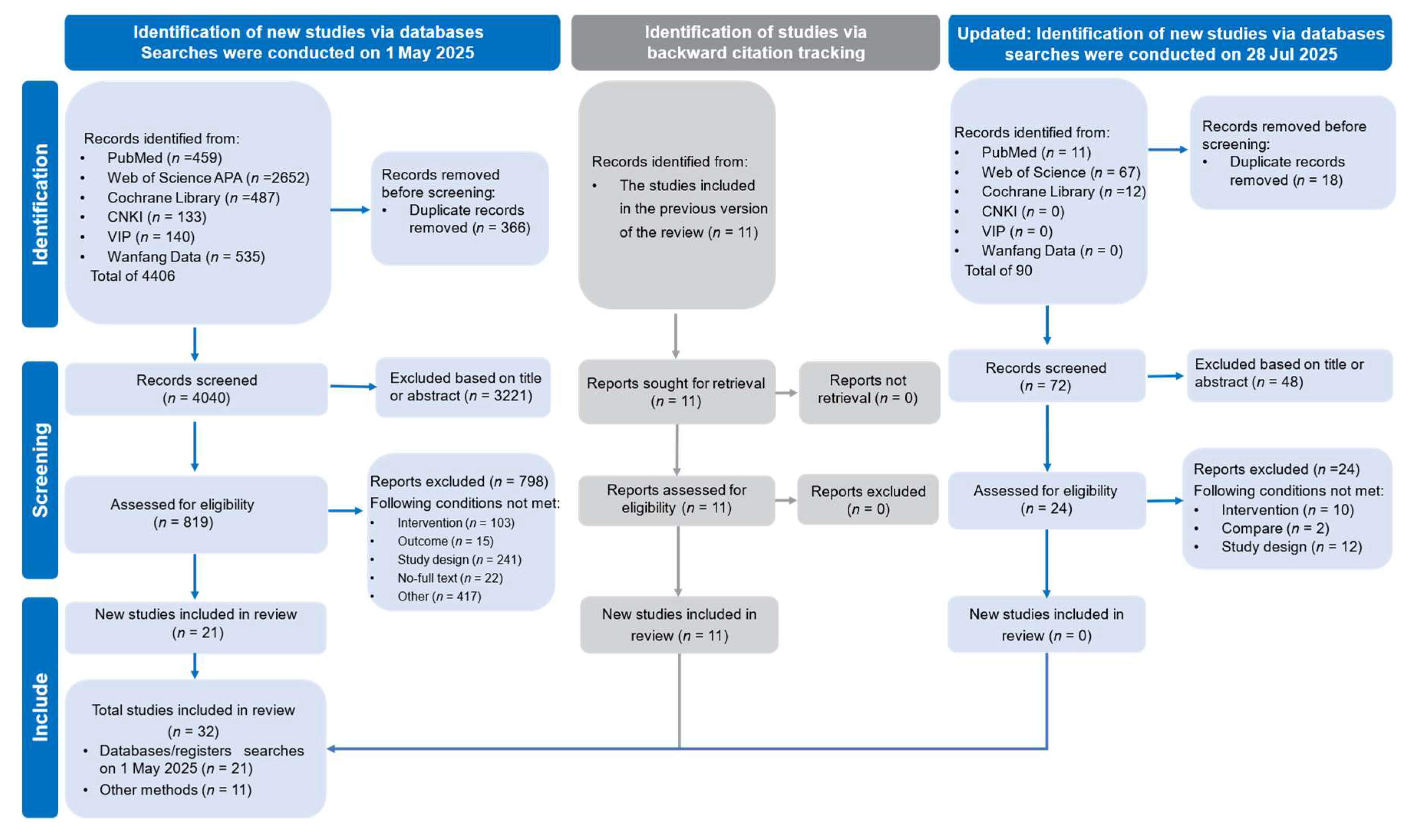
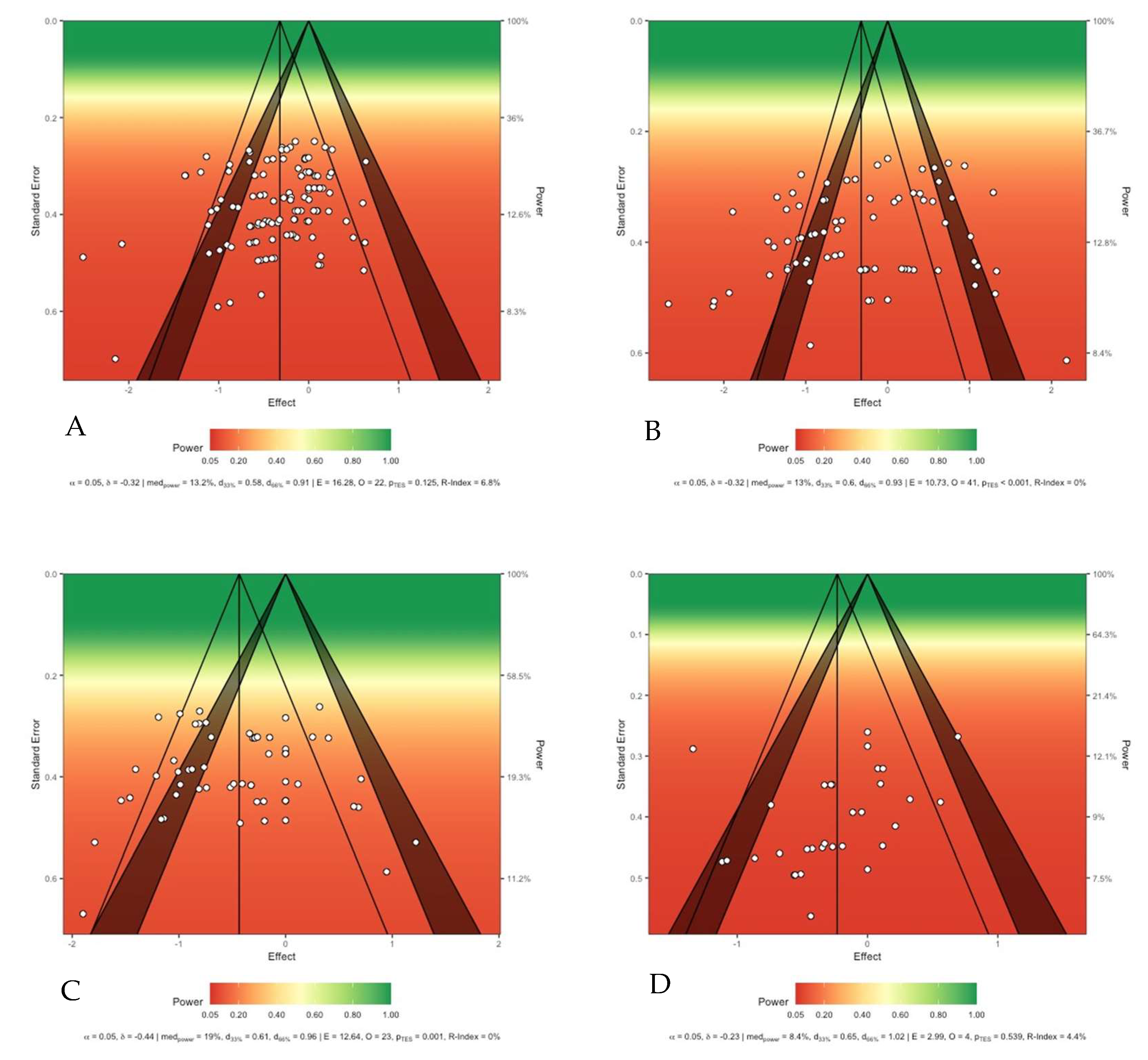
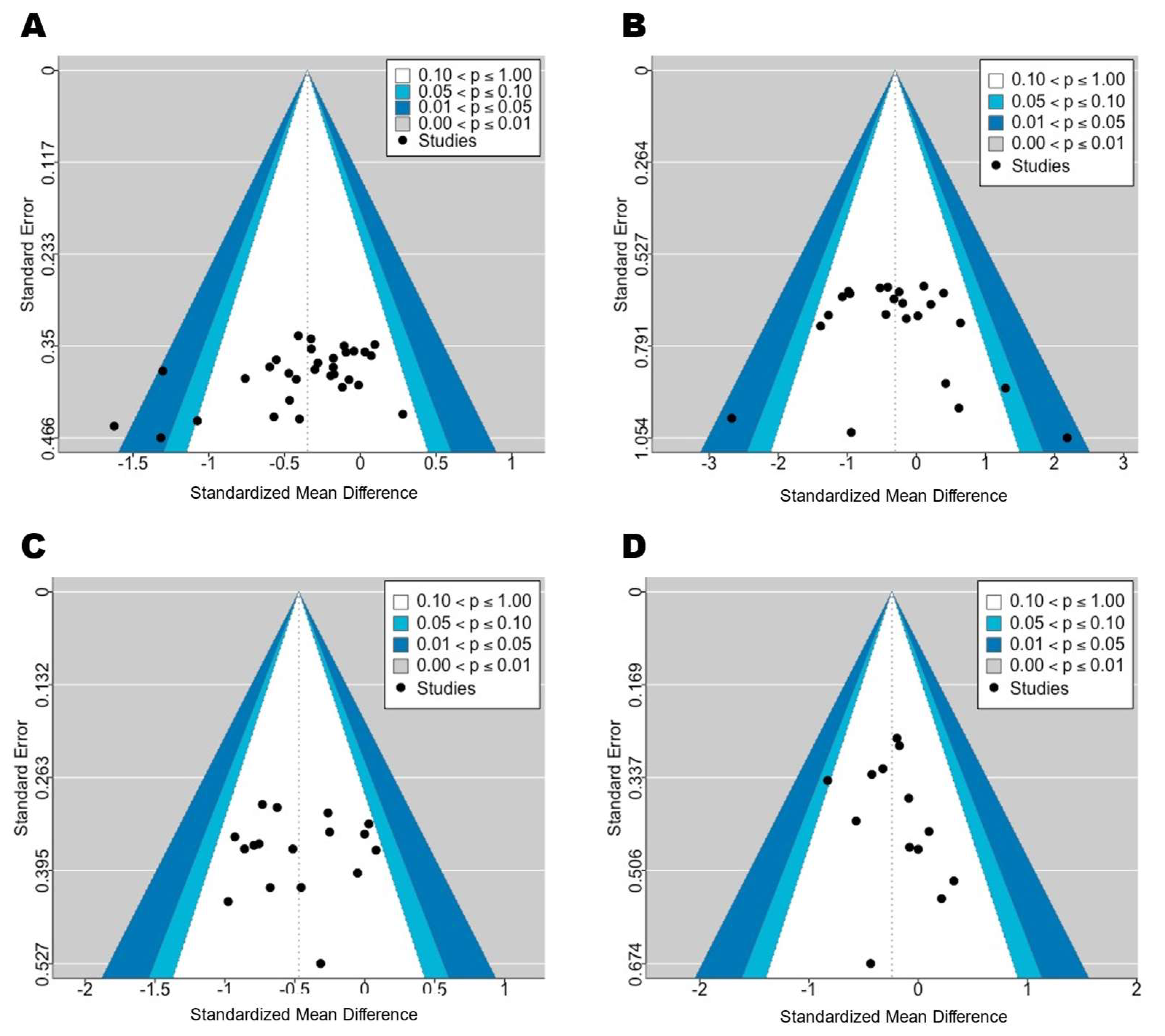
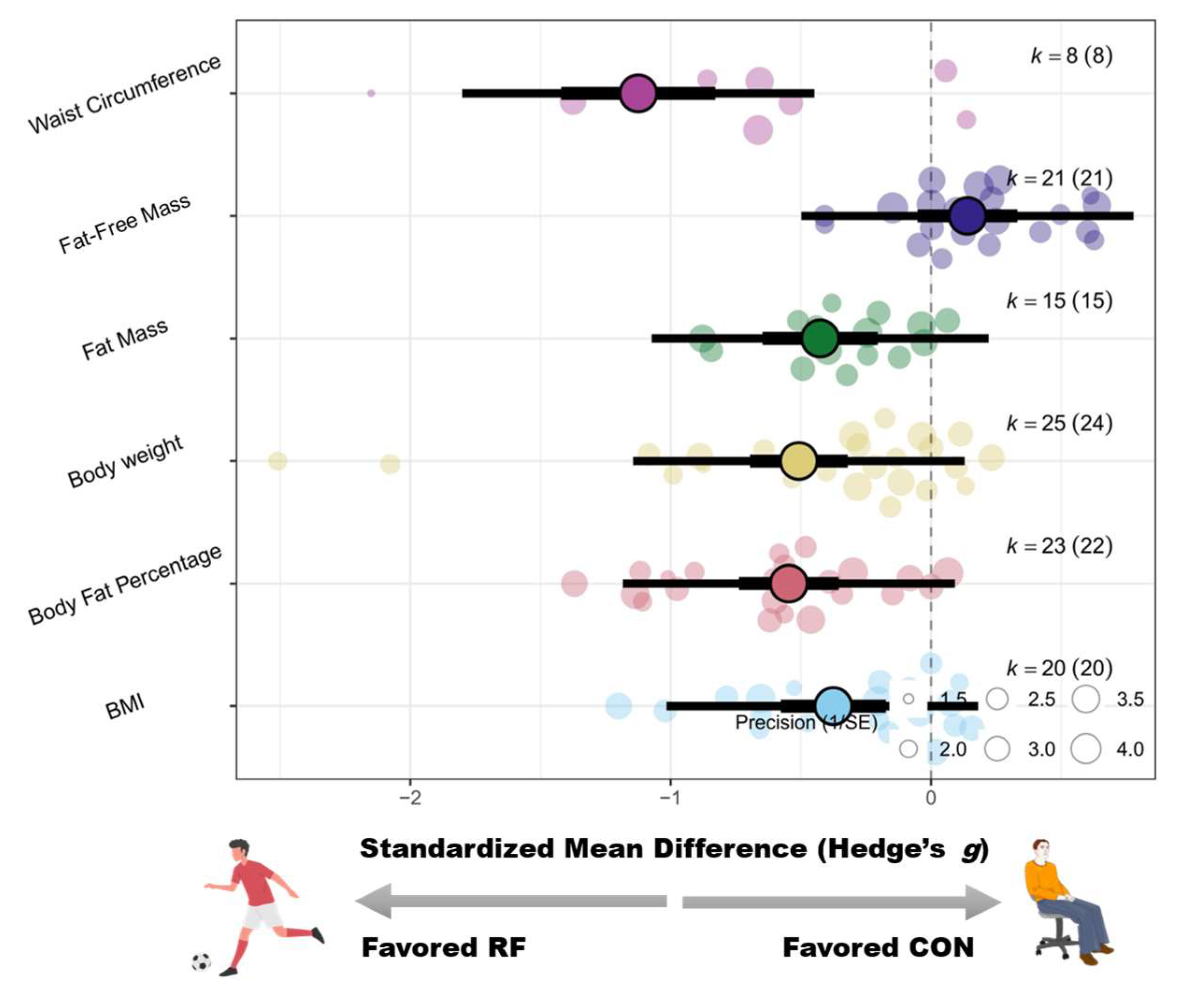
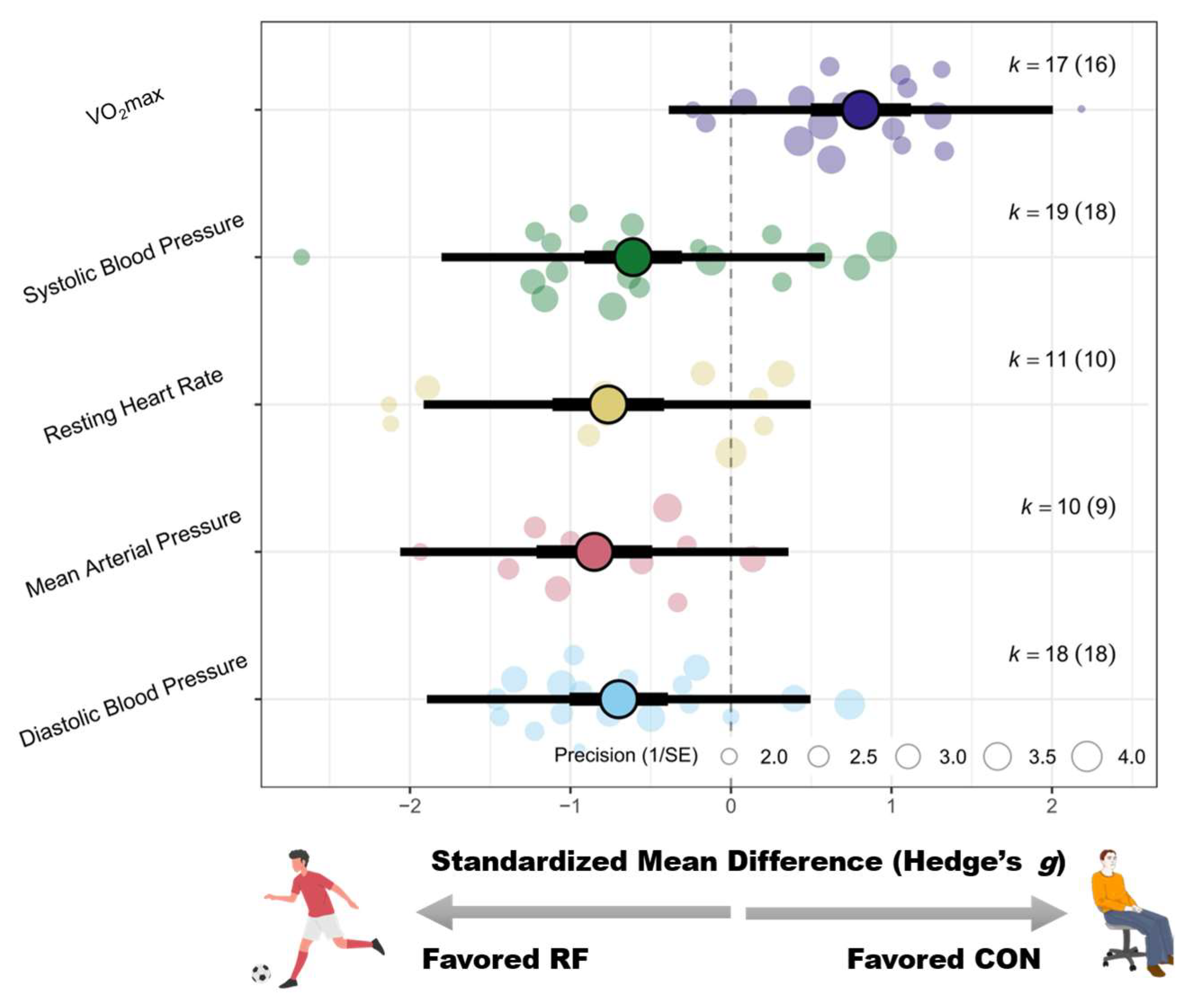
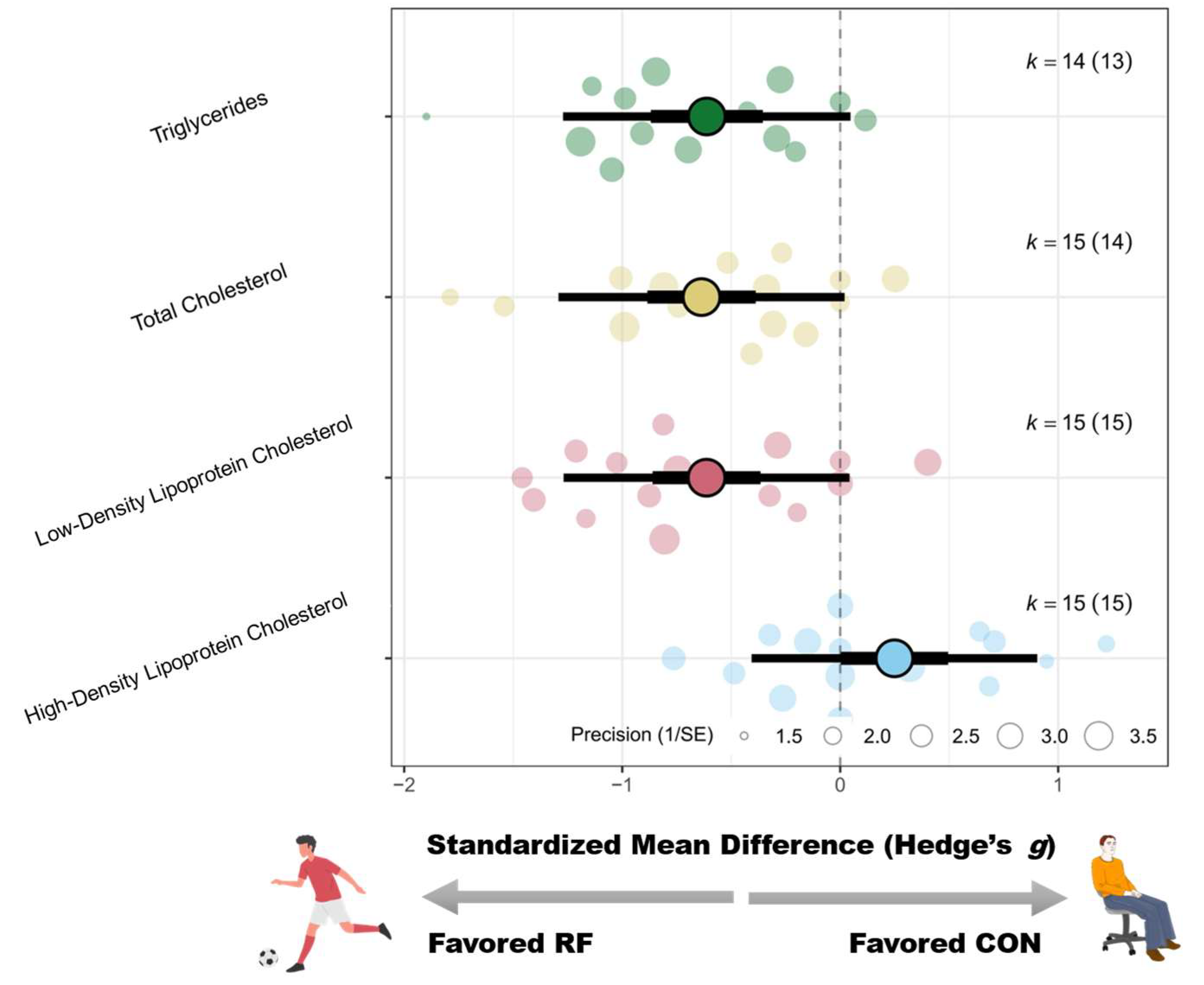
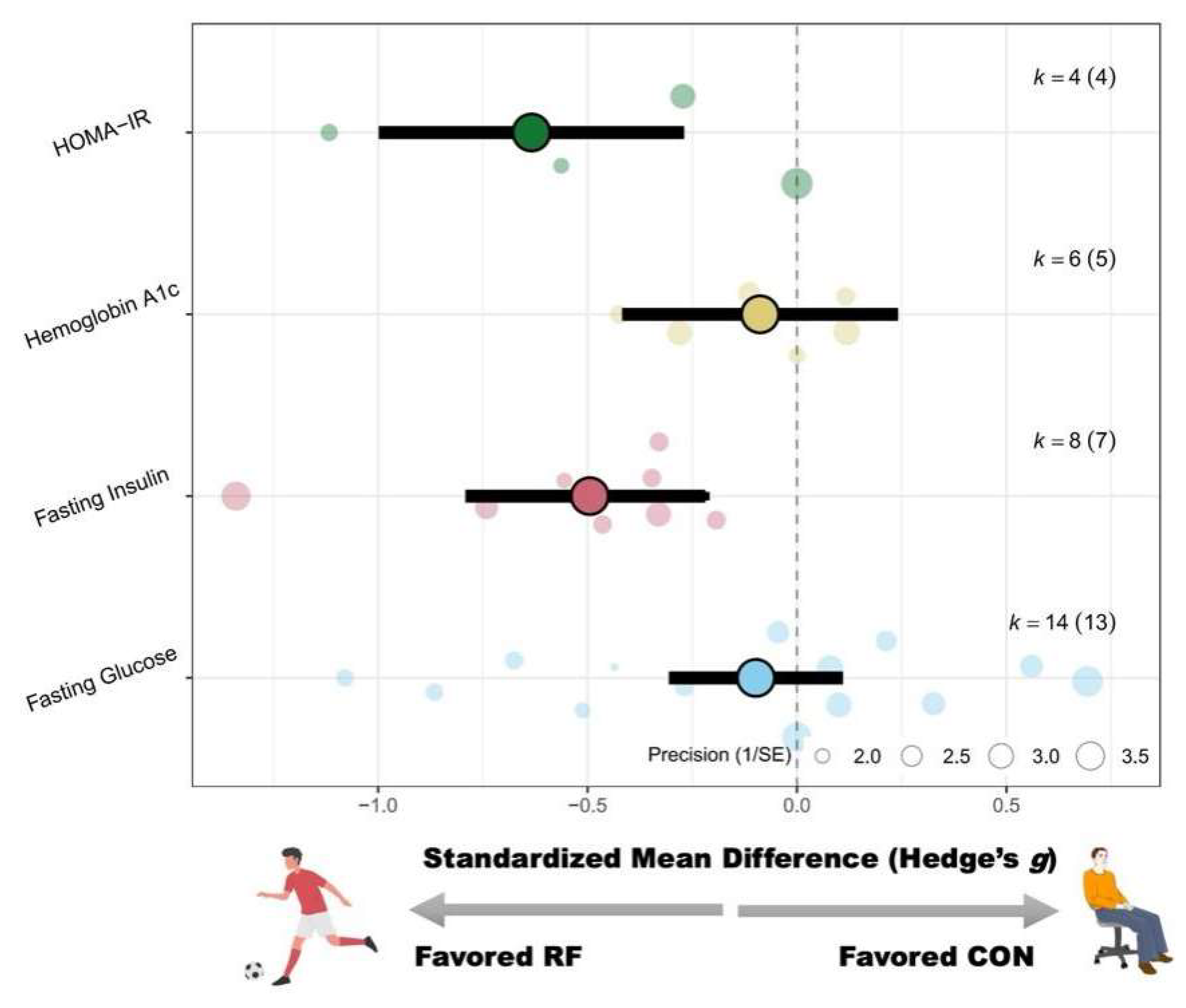
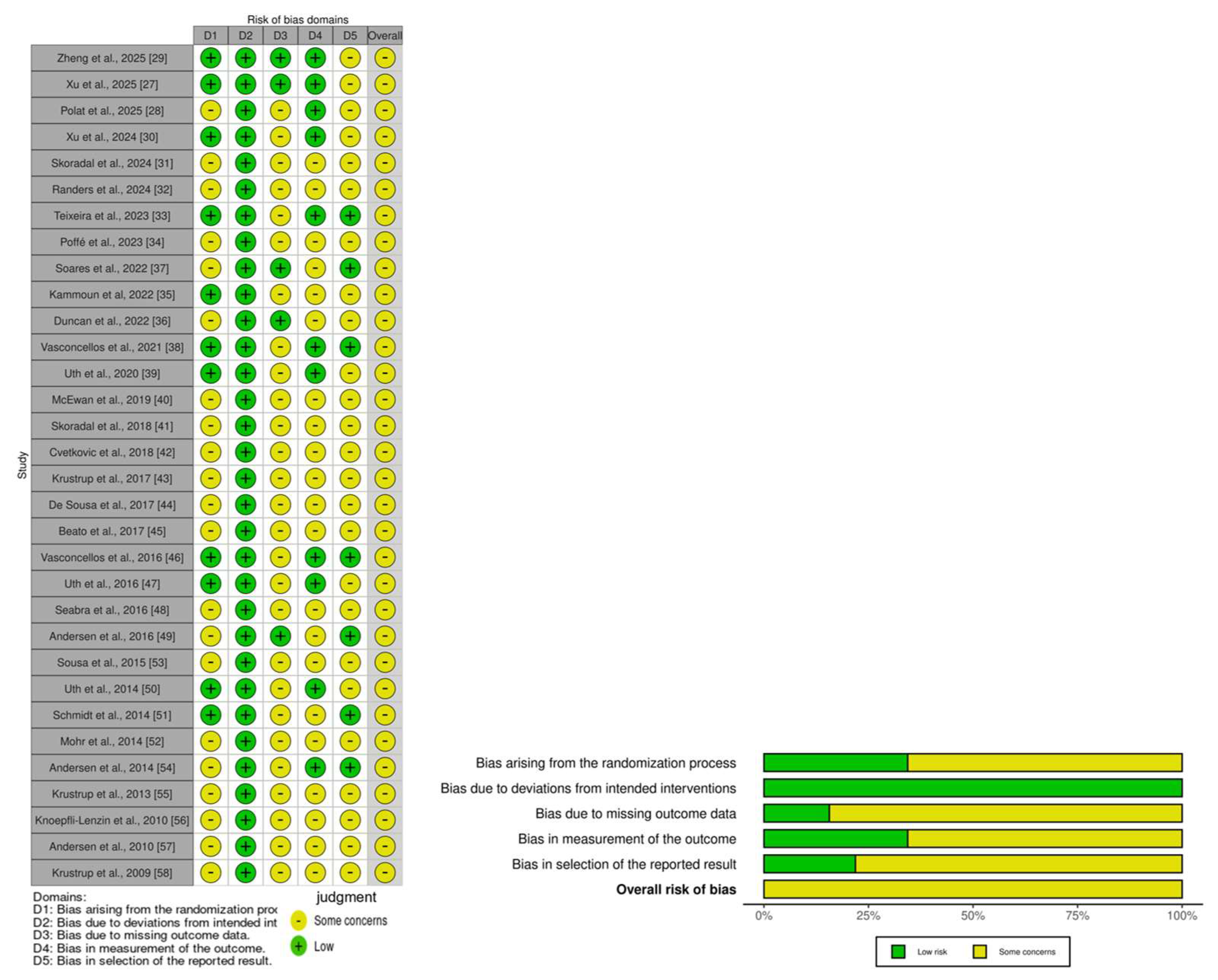
| First Author | Design | Participants | Height (cm) | Weight (kg) | BMI (kg/m2) | SSG Sessions | Fre | Wk | PEDro |
|---|---|---|---|---|---|---|---|---|---|
| Zheng, 2025 [29] | RCT | SSG: 14, Male/Female (%): 100% Con: 15, Male/Female (%): 100% SSG Age: 15.1, Con Age: 15.1 | SSG: 165.4 Con: 168.5 | SSG: 77.4 Con: 79.5 | SSG: 28.3 Con: 28.0 | Total Sets: 4 Duration per Set: 4 (min) Intermittent Recovery: 2 (min) Total Exercise Time: 16 (min) Number of Competitors: 3v3 | 2 | 6 | 8 |
| Xu, 2025 [27] | RCT | SSG: 30, Male/Female (%): 50% Con: 20, Male/Female (%): 50% SSG Age: 19.9, Con Age: 19.65 | SSG: 169 Con: 168 | SSG: 75.1 Con: 75.95 | SSG: N/A Con: N/A | Total Sets: 4 Duration per Set: 5 (min) Intermittent Recovery: 2 (min) Total Exercise Time: 20 (min) Number of Competitors: 2v2, 4v4 | 3 | 8 | 8 |
| Polat, 2025 [28] | RCT | SSG: 28, Male/Female (%): 100% Con: 29, Male/Female (%): 100% SSG Age: 65, Con Age: 66 | SSG: 170.6 Con: 167.4 | SSG: 80.1 Con: 82.7 | SSG: 27.3 Con: 27.9 | Total Sets: 3 Duration per Set: 15 (min) Intermittent Recovery: 2 (min) Total Exercise Time: 45 (min) Number of Competitors: 4v4–7v7 | 2 | 14 | 7 |
| Xu, 2024 [30] | RCT | SSG: 15, Male/Female (%): 100% Con: 15, Male/Female (%): 100% SSG (female): 15, Male/Female (%): 0% Con (female): 15, Male/Female (%): 0% SSG Age: 20.1, Con Age: 20.3 SSG (female) Age: 20.1 Con (female) Age: 20.3 | SSG: 172 Con: 162 SSG (female): 172 Con (female): 162 | SSG: 94.4 Con: 78.2 SSG (female): 94.4 Con (female): 78.2 | SSG (female): 31.3 Con (female): 29.5 | Total Sets: 2 Duration per Set: 15 (min) Intermittent Recovery: 3 (min) Total Exercise Time: 30 (min) Number of Competitors: 5v5 | 5 | 16 | 8 |
| Skoradal, 2024 [31] | RCT | SSG: 38, Male/Female (%): 47.4% Con: 28, Male/Female (%): 50% SSG Age: 65.9, Con Age: 66.9 | SSG: 171 Con: 171 | SSG: 80.0 Con: 76.8 | SSG: 27.5 Con: 26.0 | Total Sets: N/A Duration per Set: N/A Intermittent Recovery: N/A Total Exercise Time: 35–40 (min) Number of Competitors: 4v4–7v7 | 2 | 12 | 5 |
| Randers, 2024 [32] | RCT | SSG1&SSG2: 10, Male/Female (%): 100% Con: 10, Male/Female (%): 50% SSG1&SSG2-Age: 30.7, Con-Age: 30.7 | SSG1&SSG2: 183.8 Con: 183.8 | SSG1&SSG2: 90.9 Con: 90.9 | SSG1&SSG2: N/A Con: N/A | Total Sets: 4 Duration per Set: 12 (min) Intermittent Recovery: 3 (min) Total Exercise Time: 48 (min) Number of Competitors: SSG1: 2v2, 3v3 SSG2: 2v2–5v5 | 2 | 12 | 4 |
| Teixeira, 2023 [33] | RCT | SSG: 20, Male/Female (%): 100% Con: 19, Male/Female (%): 100% SSG Age: 48, Con Age: 51 | SSG: N/A Con: N/A | SSG: N/A Con: N/A | SSG: 32.2 Con: 32.0 | Total Sets: 4 Duration per Set: 10 (min) Intermittent Recovery: 2 (min) Total Exercise Time: 40 (min) Number of Competitors: 3v3–6v6 | 2 | 3 Months | 8 |
| Poffé, 2023 [34] | RCT | SSG: 15, Male/Female (%): 93.3% Con: 18, Male/Female (%): 94.4% SSG Age: 63.7, Con Age: 63.2 | SSG: 174.0 Con: 175.9 | SSG: 81.8 Con: 81.4 | SSG: 27.0 Con: 26.3 | Total Sets: 2 Duration per Set: 15 (min) Intermittent Recovery: 3 (min) Total Exercise Time: 30 (min) Number of Competitors: 4v4, 5v5 | 2 | 10 | 5 |
| Soares, 2022 [37] | RCT | SSG: 13, Male/Female (%): 61% Con: 13, Male/Female (%): 69% SSG Age: 60.5, Con Age: 60.2 | SSG: N/A Con: N/A | SSG: 87.8 Con: 85.5 | SSG: 33.2 Con: 33.3 | Total Sets: 2 Duration per Set: 12 (min) Intermittent Recovery: 3 (min) Total Exercise Time: 24 (min) Number of Competitors: 3v3–7v7 | 3 | 12 | 6 |
| Kammoun, 2022 [35] | RCT | SSG: 18, Male/Female (%): N/A Con: 13, Male/Female (%): N/A SSG Age: 53.70, Con Age: 52.75 | SSG: 177.75 Con: 175.46 | SSG: 89.1 Con: 84.6 | SSG: 28.2 Con: 27.9 | Total Sets: 1 Duration per Set: N/A Intermittent Recovery: N/A Total Exercise Time: 20 (min) Number of Competitors: 4v4, 5v5 | 3 | 4 | 7 |
| Duncan, 2022 [36] | CT | SSG: 13, Male/Female (%): 100% Con: 13, Male/Female (%): 100% SSG Age: 66, Con Age: 66 | SSG: N/A Con: N/A | SSG: N/A Con: N/A | SSG: 28.8 Con: 26.4 | Total Sets: 6 Duration per Set: 4 (min) Intermittent Recovery: 4 (min) Total Exercise Time: 24 (min) Number of Competitors: 3v3, 4v4 | 2 | 12 | 4 |
| Vasconcellos, 2021 [38] | RCT | SSG: 6, Male/Female (%): 33.3% Con: 7, Male/Female (%): 28.6% SSG Age: 13.9, Con Age: 14.7 | SSG: 160.9 Con: 163.1 | SSG: 85.1 Con: 84.7 | SSG: 30.5 Con: 30.8 | Total Sets: N/A Duration per Set: N/A Intermittent Recovery: N/A Total Exercise Time: 40 (min) Number of Competitors: 2v2–4v4 | 3 | 12 | 7 |
| Uth, 2020 [39] | RCT | SSG: 33, Male/Female (%): N/A Con: 16, Male/Female (%): N/A SSG Age: 47.4, Con Age: 50.0 | SSG: N/A Con: N/A | SSG: 72.6 Con: 76.8 | SSG: 25.5 Con: 26.4 | Total Sets: 4 Duration per Set: 7 (min) Intermittent Recovery: 2 (min) Total Exercise Time: 28 (min) Number of Competitors: 4v4, 5v5 | 2 | 12 Months | 6 |
| McEwan, 2019 [40] | CT | SSG: 9, Male/Female (%): 100% Con: 7, Male/Female (%): 100% SSG Age: 56, Con Age: 60 | SSG: 100.6 Con: 98.0 | SSG: N/A Con: N/A | SSG: 33.4 Con: 32.1 | Total Sets: N/A Duration per Set: N/A Intermittent Recovery: N/A Total Exercise Time: N/A Number of Competitors: N/A | 1 | 8 | 2 |
| Skoradal, 2018 [41] | RCT | SSG: 27, Male/Female (%): 50.9% Con: 23, Male/Female (%): 50.9% SSG Age: 60, Con Age: 62 | SSG: 172 Con: 170 | SSG: 85.0 Con: 89.9 | SSG: 28.6 Con: 30.9 | Total Sets: 2 Duration per Set: 30 (min) Intermittent Recovery: 3 (min) Total Exercise Time: 60 (min) Number of Competitors: 4v4–6v6 | 2 | 32 | 5 |
| Cvetkovic, 2018 [42] | RCT | SSG: 10, Male/Female (%): 100% Con: 14, Male/Female (%): 100% SSG Age: 11–13, Con Age: 11–13 | SSG: 157.9 Con: 162.7 | SSG: 63.7 Con: 67.4 | SSG: 25.4 Con: 25.3 | Total Sets: 4 Duration per Set: 8 (min) Intermittent Recovery: 2 (min) Total Exercise Time: 32 (min) Number of Competitors: 5v5–7v7 | 3 | 12 | 4 |
| Krustrup, 2017 [43] | RCT | SSG: 19, Male/Female (%): 0% Con: 12, Male/Female (%): 0% SSG Age: 45, Con Age: 45 | SSG: 165 Con: 166 | SSG: 75.1 Con: 78.9 | SSG: N/A Con: N/A | Total Sets: 4 Duration per Set: 12 (min) Intermittent Recovery: N/A Total Exercise Time: 48 (min) Number of Competitors: 4v4–8v8 | 3 | 12 Months | 4 |
| De Sousa, 2017 [44] | RCT | SSG: 22, Male/Female (%): 43.1% Con: 29, Male/Female (%): 43.1% SSG Age: 61, Con Age: 61 | SSG: N/A Con: N/A | SSG: N/A Con: N/A | SSG: 33.0 Con: 32.7 | Total Sets: 4 Duration per Set: 4 (min) Intermittent Recovery: 2 (min) Total Exercise Time: 16 (min) Number of Competitors: 3v3–7v7 | 3 | 12 | 4 |
| Beato, 2017 [45] | RCT | SSG: 10, Male/Female (%): 100% Con: 14, Male/Female (%): 100% SSG Age: 42.9, Con Age: 45.6 | SSG: 175.1 Con: 174.9 | SSG: 82.1 Con: 81.8 | SSG: 26.7 Con: 26.7 | Total Sets: 1 Duration per Set: N/A Intermittent Recovery: N/A Total Exercise Time: 55 (min) Number of Competitors: 5v5 | 1 | 12 | 5 |
| Vasconcellos, 2016 [46] | RCT | SSG: 10, Male/Female (%): 80% Con: 10, Male/Female (%): 60% SSG Age: 14.1, Con Age: 14.8 | SSG: 163.1 Con: 161.2 | SSG: 82.2 Con: 86.3 | SSG: 30.3 Con: 32.2 | Total Sets: 4 Duration per Set: 4 (min) Intermittent Recovery: 2 (min) Total Exercise Time: 16 (min) Number of Competitors: 2v2–4v4 | 3 | 12 | 7 |
| Uth, 2016 [47] | RCT | SSG: 29, Male/Female (%): 100% Con: 28, Male/Female (%): 100% SSG Age: 67.1, Con Age: 66.5 | SSG: N/A Con: N/A | SSG: N/A Con: N/A | SSG: 26.6 Con: 27.6 | Total Sets: 3 Duration per Set: 15 (min) Intermittent Recovery: N/A Total Exercise Time: 45 (min) Number of Competitors: N/A | 3 | 32 | 5 |
| Seabra, 2016 [48] | CT | SSG: 29, Male/Female (%): 100% Con: 30, Male/Female (%): 100% SSG Age: 10.5, Con Age: 10.0 | SSG: 147.5 Con: 145.3 | SSG: 52.5 Con: 53.6 | SSG: 23.7 Con: 25.1 | Total Sets: N/A Duration per Set: N/A Intermittent Recovery: N/A Total Exercise Time: 40–60 (min) Number of Competitors: N/A | 3 | 6 Months | 5 |
| Andersen, 2016 [49] | RCT | SSG: 9, Male/Female (%): 100% Con: 8, Male/Female (%): 100% SSG Age: 68.0, Con Age: 67.4 | SSG: 173.3 Con: 179.0 | SSG: 77.7 Con: 89.3 | SSG: 26.1 Con: 27.9 | Total Sets: 4 Duration per Set: 15 (min) Intermittent Recovery: 2 (min) Total Exercise Time: 60 (min) Number of Competitors: 3v3–5v5 | 2 | 52 | 6 |
| Sousa, 2015 [53] | RCT | SSG: 19, Male/Female (%): 52.6% Con: 15, Male/Female (%): 33.3% SSG Age: 48–68, Con Age: 48–68 | SSG: N/A Con: N/A | SSG: 88.9 Con: 82.9 | SSG: 32.7 Con: 33.1 | Total Sets: 2 Duration per Set: 12 (min) Intermittent Recovery: 2 (min) Total Exercise Time: 24 (min) Number of Competitors: 3v3–7v7 | 3 | 12 | 5 |
| Uth, 2014 [50] | RCT | SSG: 21, Male/Female (%): 100% Con: 20, Male/Female (%): 100% SSG Age: 67.1, Con Age: 66.5 | SSG: 177.0 Con: 180.8 | SSG: 83.4 Con: 89.0 | SSG: 26.6 Con: 27.6 | Total Sets: 3 Duration per Set: 15 (min) Intermittent Recovery: N/A Total Exercise Time: 45 (min) Number of Competitors: 5v5–7v7 | 3 | 12 | 8 |
| Schmidt, 2014 [51] | RCT | SSG: 9, Male/Female (%): 100% Con: 8, Male/Female (%): 100% SSG Age: 68.0, Con Age: 67.4 | SSG: 173.3 Con: 179.0 | SSG: 77.7 Con: 89.3 | SSG: 26.1 Con: 27.9 | Total Sets: 4 Duration per Set: 15 (min) Intermittent Recovery: 2 (min) Total Exercise Time: 60 (min) Number of Competitors: 3v3–5v5 | 3 | 12 Months | 7 |
| Mohr, 2014 [52] | RCT | SSG: 21, Male/Female (%): 0% Con: 20, Male/Female (%): 0% SSG Age: 45, Con Age: 43 | SSG: 165 Con 166 | SSG: 79.8 Con: 77.3 | SSG: N/A Con: N/A | Total Sets: N/A Duration per Set: N/A Intermittent Recovery: N/A Total Exercise Time: N/A Number of Competitors: 4v4–10v10 | 3 | 15 | 6 |
| Andersen, 2014 [54] | CT | SSG: 12, Male/Female (%): 100% Con: 9, Male/Female (%): 100% SSG Age: 50.6, Con Age: 48.7 | SSG: N/A Con: N/A | SSG: N/A Con: N/A | SSG: 30.4 Con: 30.4 | Total Sets: 5 Duration per Set: 10 (min) Intermittent Recovery: 2 (min) Total Exercise Time: 50 (min) Number of Competitors: 4v4–6v6 | 2 | 24 | 5 |
| Krustrup, 2013 [55] | RCT | SSG: 22, Male/Female (%): 100% Con: 11, Male/Female (%): 100% SSG Age: 46, Con Age: 46 | SSG: N/A Con: N/A | SSG: 97.8 Con: 97.8 | SSG: 30.0 Con: 30.0 | Total Sets: 4 Duration per Set: 12 (min) Intermittent Recovery: 2 (min) Total Exercise Time: 48 (min) Number of Competitors: 5v5–7v7 | 2 | 6 Months | 6 |
| Knoepfli-Lenzin, 2010 [56] | RCT | SSG: 15, Male/Female (%): 100% Con: 17, Male/Female (%): 100% SSG Age: 37, Con Age: 38 | SSG: N/A Con: N/A | SSG: N/A Con: N/A | SSG: 26 Con: 27 | Total Sets: N/A Duration per Set: N/A Intermittent Recovery: N/A Total Exercise Time: 50 (min) Number of Competitors: 3v3–5v5 | 3 | 12 | 6 |
| Andersen, 2010 [57] | RCT | SSG: 15, Male/Female (%): 100% Con: 10, Male/Female (%): 100% SSG Age: 46.7, Con Age: 47.8 | SSG: 181 Con: 182 | SSG: 100.1 Con: 100.0 | SSG: 30.4 Con: 30.0 | Total Sets: 2 Duration per Set: 25 (min) Intermittent Recovery: 2 (min) Total Exercise Time: 50 (min) Number of Competitors: 5v5–7v7 | 2 | 3 Months | 6 |
| Krustrup, 2009 [58] | RCT | SSG: 13, Male/Female (%): 100% Con: 11, Male/Female (%): 100% SSG Age: 20–43, Con Age: 20–43 | SSG: N/A Con: N/A | SSG: 84.4 Con: 84.4 | SSG: 25.6 Con: 25.6 | Total Sets: N/A Duration per Set: N/A Intermittent Recovery: N/A Total Exercise Time: 55 (min) Number of Competitors: 5v5–7v7 | 2 | 12 | 5 |
| Study | D1 | D2 | D3 | D4 | D5 | Overall |
|---|---|---|---|---|---|---|
| Zheng et al., 2025 [29] | Low | Low | Low | Low | Some concerns | Some concerns |
| Xu et al., 2025 [27] | Low | Low | Low | Low | Some concerns | Some concerns |
| Polat et al., 2025 [28] | Some concerns | Low | Some concerns | Low | Some concerns | Some concerns |
| Xu et al., 2024 [30] | Low | Low | Some concerns | Low | Some concerns | Some concerns |
| Skoradal et al., 2024 [31] | Some concerns | Low | Some concerns | Some concerns | Some concerns | Some concerns |
| Randers et al., 2024 [32] | Some concerns | Low | Some concerns | Some concerns | Some concerns | Some concerns |
| Teixeira et al., 2023 [33] | Low | Low | Some concerns | Low | Low | Some concerns |
| Poffé et al., 2023 [34] | Some concerns | Low | Some concerns | Some concerns | Some concerns | Some concerns |
| Soares et al., 2022 [37] | Some concerns | Low | Low | Some concerns | Low | Some concerns |
| Kammoun et al., 2022 [35] | Low | Low | Some concerns | Some concerns | Some concerns | Some concerns |
| Duncan et al., 2022 [36] | Some concerns | Low | Low | Some concerns | Some concerns | Some concerns |
| Vasconcellos et al., 2021 [38] | Low | Low | Some concerns | Low | Low | Some concerns |
| Uth et al., 2020 [39] | Low | Low | Some concerns | Low | Some concerns | Some concerns |
| McEwan et al., 2019 [40] | Some concerns | Low | Some concerns | Some concerns | Some concerns | Some concerns |
| Skoradal et al., 2018 [41] | Some concerns | Low | Some concerns | Some concerns | Some concerns | Some concerns |
| Cvetkovic et al., 2018 [42] | Some concerns | Low | Some concerns | Some concerns | Some concerns | Some concerns |
| Krustrup et al., 2017 [43] | Some concerns | Low | Some concerns | Some concerns | Some concerns | Some concerns |
| De Sousa et al., 2017 [44] | Some concerns | Low | Some concerns | Some concerns | Some concerns | Some concerns |
| Beato et al., 2017 [45] | Some concerns | Low | Some concerns | Some concerns | Some concerns | Some concerns |
| Vasconcellos et al., 2016 [46] | Low | Low | Some concerns | Low | Low | Some concerns |
| Uth et al., 2016 [47] | Low | Low | Some concerns | Low | Some concerns | Some concerns |
| Seabra et al., 2016 [48] | Some concerns | Low | Some concerns | Some concerns | Some concerns | Some concerns |
| Andersen et al., 2016 [49] | Some concerns | Low | Low | Some concerns | Low | Some concerns |
| Sousa et al., 2015 [53] | Some concerns | Low | Some concerns | Some concerns | Some concerns | Some concerns |
| Uth et al., 2014 [50] | Low | Low | Some concerns | Low | Some concerns | Some concerns |
| Schmidt et al., 2014 [51] | Low | Low | Some concerns | Some concerns | Low | Some concerns |
| Mohr et al., 2014 [52] | Some concerns | Low | Some concerns | Some concerns | Some concerns | Some concerns |
| Andersen et al., 2014 [54] | Some concerns | Low | Some concerns | Low | Low | Some concerns |
| Krustrup et al., 2013 [55] | Some concerns | Low | Some concerns | Some concerns | Some concerns | Some concerns |
| Knoepfli-Lenzin et al., 2010 [56] | Some concerns | Low | Some concerns | Some concerns | Some concerns | Some concerns |
| Andersen et al., 2010 [57] | Some concerns | Low | Some concerns | Some concerns | Some concerns | Some concerns |
| Krustrup et al., 2009 [58] | Some concerns | Low | Some concerns | Some concerns | Some concerns | Some concerns |
| Author, Year | D1 | D2 | D3 | D4 | D5 | D6 | D7 | D8 | D9 | D10 | D11 | Total |
|---|---|---|---|---|---|---|---|---|---|---|---|---|
| Zheng et al., 2025 [29] | Y | 1 | 1 | 1 | 0 | 0 | 1 | 1 | 1 | 1 | 1 | 8 |
| Xu et al., 2025 [27] | Y | 1 | 1 | 1 | 0 | 0 | 1 | 1 | 1 | 1 | 1 | 8 |
| Polat et al., 2025 [28] | Y | 1 | 0 | 1 | 0 | 0 | 1 | 1 | 1 | 1 | 1 | 7 |
| Xu et al., 2024 [30] | Y | 1 | 1 | 1 | 0 | 0 | 1 | 1 | 1 | 1 | 1 | 8 |
| Skoradal et al., 2024 [31] | Y | 1 | 0 | 0 | 0 | 0 | 0 | 1 | 1 | 1 | 1 | 5 |
| Randers et al., 2024 [32] | Y | 1 | 0 | 0 | 0 | 0 | 0 | 0 | 1 | 1 | 1 | 4 |
| Teixeira et al., 2023 [33] | Y | 1 | 1 | 1 | 0 | 0 | 1 | 1 | 1 | 1 | 1 | 8 |
| Poffé et al., 2023 [34] | N | 1 | 0 | 0 | 0 | 0 | 0 | 1 | 1 | 1 | 1 | 5 |
| Soares et al., 2022 [37] | Y | 1 | 0 | 1 | 0 | 0 | 0 | 1 | 1 | 1 | 1 | 6 |
| Kammoun et al., 2022 [35] | Y | 1 | 1 | 1 | 0 | 0 | 0 | 1 | 1 | 1 | 1 | 7 |
| Duncan et al., 2022 [36] | Y | 0 | 0 | 0 | 0 | 0 | 0 | 1 | 1 | 1 | 1 | 4 |
| Vasconcellos et al., 2021 [38] | Y | 1 | 1 | 1 | 0 | 0 | 1 | 0 | 1 | 1 | 1 | 7 |
| Uth et al., 2020 [39] | Y | 1 | 1 | 0 | 0 | 0 | 1 | 0 | 1 | 1 | 1 | 6 |
| McEwan et al., 2019 [40] | Y | 0 | 0 | 0 | 0 | 0 | 0 | 0 | 1 | 0 | 1 | 2 |
| Skoradal et al., 2018 [41] | Y | 1 | 0 | 0 | 0 | 0 | 0 | 1 | 1 | 1 | 1 | 5 |
| Cvetkovic et al., 2018 [42] | Y | 1 | 0 | 1 | 0 | 0 | 0 | 0 | 1 | 0 | 1 | 4 |
| Krustrup et al., 2017 [43] | Y | 1 | 0 | 0 | 0 | 0 | 0 | 0 | 1 | 1 | 1 | 4 |
| De Sousa et al., 2017 [44] | Y | 1 | 0 | 0 | 0 | 0 | 0 | 0 | 1 | 1 | 1 | 4 |
| Beato et al., 2017 [45] | Y | 1 | 0 | 1 | 0 | 0 | 0 | 0 | 1 | 1 | 1 | 5 |
| Vasconcellos et al., 2016 [46] | Y | 1 | 1 | 1 | 0 | 0 | 1 | 0 | 1 | 1 | 1 | 7 |
| Uth et al., 2016 [47] | N | 1 | 0 | 1 | 0 | 0 | 0 | 0 | 1 | 1 | 1 | 5 |
| Seabra et al., 2016 [48] | Y | 0 | 0 | 1 | 0 | 0 | 0 | 1 | 1 | 1 | 1 | 5 |
| Andersen et al., 2016 [49] | Y | 1 | 0 | 1 | 0 | 0 | 0 | 1 | 1 | 1 | 1 | 6 |
| Sousa et al., 2015 [53] | Y | 1 | 0 | 1 | 0 | 0 | 0 | 0 | 1 | 1 | 1 | 5 |
| Uth et al., 2014 [50] | Y | 1 | 1 | 1 | 0 | 0 | 1 | 1 | 1 | 1 | 1 | 8 |
| Schmidt et al., 2014 [51] | Y | 1 | 1 | 1 | 0 | 0 | 0 | 1 | 1 | 1 | 1 | 7 |
| Mohr et al., 2014 [52] | Y | 1 | 0 | 1 | 0 | 0 | 0 | 1 | 1 | 1 | 1 | 6 |
| Andersen et al., 2014 [54] | Y | 0 | 0 | 0 | 0 | 0 | 1 | 1 | 1 | 1 | 1 | 5 |
| Krustrup et al., 2013 [55] | Y | 1 | 0 | 1 | 0 | 0 | 0 | 1 | 1 | 1 | 1 | 6 |
| Knoepfli-Lenzin et al., 2010 [56] | Y | 1 | 0 | 1 | 0 | 0 | 0 | 1 | 1 | 1 | 1 | 6 |
| Andersen et al., 2010 [57] | Y | 1 | 0 | 1 | 0 | 0 | 0 | 1 | 1 | 1 | 1 | 6 |
| Krustrup et al., 2009 [58] | Y | 1 | 0 | 0 | 0 | 0 | 0 | 1 | 1 | 1 | 1 | 5 |
| Outcome | No. of Participants (Studies) | Certainty Assessment | Standardized Mean Effect (95% CI) | GRADE * | ||||
|---|---|---|---|---|---|---|---|---|
| Risk of Bias | Inconsistency | Indirectness | Imprecision | Other | ||||
| Body Composition | ||||||||
| Body Weight | 24 (26 RCTs) | Serious | Serious | Not serious | Not serious | None | −0.51 (−0.79 to −0.23) | ⨁⨁◯◯ LOW |
| Body Weight Index | 21 (20 RCTs) | Serious | Not serious | Not serious | Not serious | None | −0.41 (−0.66 to −0.15) | ⨁⨁⨁◯ MODERATE |
| Body Fat Percentage | 23 (34 RCTs) | Serious | Serious | Not serious | Not serious | None | −0.53 (−0.72 to −0.35) | ⨁⨁◯◯ LOW |
| Fat-Free Mass | 21 (20 RCTs) | Serious | Serious | Not serious | Not serious | None | 0.18 (0.03 to 0.32) | ⨁⨁◯◯ LOW |
| Fat Mass | 16 (16 RCTs) | Serious | Not serious | Not serious | Serious | None | −0.40 (−0.60 to −0.20) | ⨁⨁◯◯ LOW |
| Waist Circumstance | 10 (11 RCTs) | Serious | Serious | Not serious | Not serious | Large Effect Size | −1.43 (−2.24 to −0.61) | ⨁⨁⨁◯ MODERATE |
| Cardiovascular Health | ||||||||
| Systolic Blood Pressure | 19 (20 RCTs) | Serious | Serious | Not serious | Not serious | None | −0.59 (−0.99 to −0.18) | ⨁⨁◯◯ LOW |
| Diastolic Blood Pressure | 19 (19 RCTs) | Serious | Not serious | Not serious | Not serious | None | −0.75 (−1.10 to −0.39) | ⨁⨁⨁◯ MODERATE |
| Mean Arterial Pressure | 10 (11 RCTs) | Serious | Not serious | Not serious | Not serious | Large effect size | −0.91 (−1.37 to −0.46) | ⨁⨁⨁◯ MODERATE |
| Resting Heart Rate | 11 (12 RCTs) | Serious | Serious | Not serious | Not serious | Large effect size | −0.85 (−1.42 to −0.27) | ⨁⨁⨁◯ MODERATE |
| VO2max/VO2peak | 17 (18 RCTs) | Serious | Serious | Not serious | Not serious | Large effect size | 0.81 (0.54 to 1.09) | ⨁⨁⨁◯ MODERATE |
| Glucose and Lipid Metabolism | ||||||||
| Total Cholesterol | 15 (16 RCTs) | Serious | Serious | Not serious | Not serious | None | −0.62 (−0.91 to −0.34) | ⨁⨁◯◯ LOW |
| LDL Cholesterol | 15 (16 RCTs) | Serious | Serious | Not serious | Not serious | None | −0.58 (−0.88 to −0.29) | ⨁⨁◯◯ LOW |
| Triglyceride | 14 (15 RCTs) | Serious | Not serious | Not serious | Not serious | None | −0.61 (−0.87 to −0.36) | ⨁⨁◯◯ LOW |
| Fasting Insulin | 8 (9 RCTs) | Serious | Serious | Not serious | Not serious | None | −0.47 (−0.83 to −0.11) | ⨁⨁◯◯ LOW |
| HDL Cholesterol | 16 (16 RCTs) | Serious | Serious | Not serious | Serious | None | 0.24 (−0.10 to 0.57) | ⨁◯◯◯ VERY LOW |
| Fasting Glucose | 14 (15 RCTs) | Serious | Serious | Not serious | Serious | None | −0.21 (−0.57 to 0.14) | ⨁◯◯◯ VERY LOW |
| HbA1c | 6 (7 RCTs) | Serious | Serious | Not serious | Serious | None | −0.15 (−0.45 to 0.15) | ⨁⨁◯◯ LOW |
| HOMA-IR | 5 (5 RCTs) | Serious | Not serious | Not serious | Serious | Large effect size | −0.89 (−1.86 to 0.07) | ⨁⨁◯◯ LOW |
Disclaimer/Publisher’s Note: The statements, opinions and data contained in all publications are solely those of the individual author(s) and contributor(s) and not of MDPI and/or the editor(s). MDPI and/or the editor(s) disclaim responsibility for any injury to people or property resulting from any ideas, methods, instructions or products referred to in the content. |
© 2025 by the authors. Licensee MDPI, Basel, Switzerland. This article is an open access article distributed under the terms and conditions of the Creative Commons Attribution (CC BY) license (https://creativecommons.org/licenses/by/4.0/).
Share and Cite
Li, S.; Li, H.; Wang, B.; Zeng, Z.; Zhang, R.; Yan, H.; Zhou, A.; Xie, Y.; Zhou, C. Effects of Recreational Football on Body Composition and Cardiometabolic Health in Overweight or Obese Individuals: A Systematic Review and Meta-Analysis. Life 2025, 15, 1276. https://doi.org/10.3390/life15081276
Li S, Li H, Wang B, Zeng Z, Zhang R, Yan H, Zhou A, Xie Y, Zhou C. Effects of Recreational Football on Body Composition and Cardiometabolic Health in Overweight or Obese Individuals: A Systematic Review and Meta-Analysis. Life. 2025; 15(8):1276. https://doi.org/10.3390/life15081276
Chicago/Turabian StyleLi, Sijia, Haoran Li, Bo Wang, Zhuo Zeng, Rui Zhang, Henghao Yan, Aiguo Zhou, Yongmin Xie, and Chengyu Zhou. 2025. "Effects of Recreational Football on Body Composition and Cardiometabolic Health in Overweight or Obese Individuals: A Systematic Review and Meta-Analysis" Life 15, no. 8: 1276. https://doi.org/10.3390/life15081276
APA StyleLi, S., Li, H., Wang, B., Zeng, Z., Zhang, R., Yan, H., Zhou, A., Xie, Y., & Zhou, C. (2025). Effects of Recreational Football on Body Composition and Cardiometabolic Health in Overweight or Obese Individuals: A Systematic Review and Meta-Analysis. Life, 15(8), 1276. https://doi.org/10.3390/life15081276







